Samsung QN85D is the entry-level model in the Neo QLED series for 2024, but it certainly doesn’t come across as a "budget" option. It’s a television that combines modern technology with convenient smart features. During tests, the Tizen system operated smoothly, and integration with the SmartThings ecosystem made it easy to connect other devices in the home. If we use Apple devices, AirPlay works flawlessly, which is convenient, especially for viewing photos or videos from our phone. As for its performance during daily use, it simply works very well. The television handles viewing even in bright rooms – its brightness is sufficient that there’s no need to cover the windows. Additionally, the stable central stand not only looks good but also adds confidence that the device is standing securely and will definitely fit on smaller furniture. There is a lack of recording function, but the solar remote control, which operates decoders (e.g. Canal+) and the PiP function are practical additions that anyone who enjoys spending time watching regular television will appreciate. As for the picture – because that’s the most important thing in a TV – the QN85D makes a great impression. The VA panel provides very good blacks – especially if we watch the television head-on. Thanks to miniLED backlighting, the television better controls the light, resulting in much more detail visible in dark scenes. When it comes to motion fluidity, the television performs excellently thanks to the 120 Hz refresh rate – both games and matches are enjoyable to watch. If we’re gaming, low input lag combined with an excellent motion smoother and game bar will be a significant advantage – gameplay will be a pleasure. Samsung QN85D is a versatile television that will perform well for both everyday television watching and more demanding sessions or gaming on a console. Although it lacks some features, such as recording, its picture quality, motion fluidity, and smart capabilities definitely make up for these shortcomings. If we’re looking for a modern yet affordable Mini LED model, QN85D will be a very good choice.
- Matching (Score)
- Our verdict
- TV appearance
- Where to buy
- Contrast and black detail
- HDR effect quality
- Factory color reproduction
- Color reproduction after calibration
- Smoothness of tonal transitions
- Image scaling and smoothness of tonal transitions
- Blur and motion smoothness
- Console compatibility and gaming features
- Input lag
- Compatibility with PC
- Viewing angles
- TV efficiency during daytime
- Details about the matrix
- TV features
- Apps
- Playing files from USB
- Sound
Samsung Neo QLED QN85D / QNX1D vs Philips MLED920 / MLED910
Direct compare
Neo QLED / QN85D / QNX1D
MLED920 / MLED910

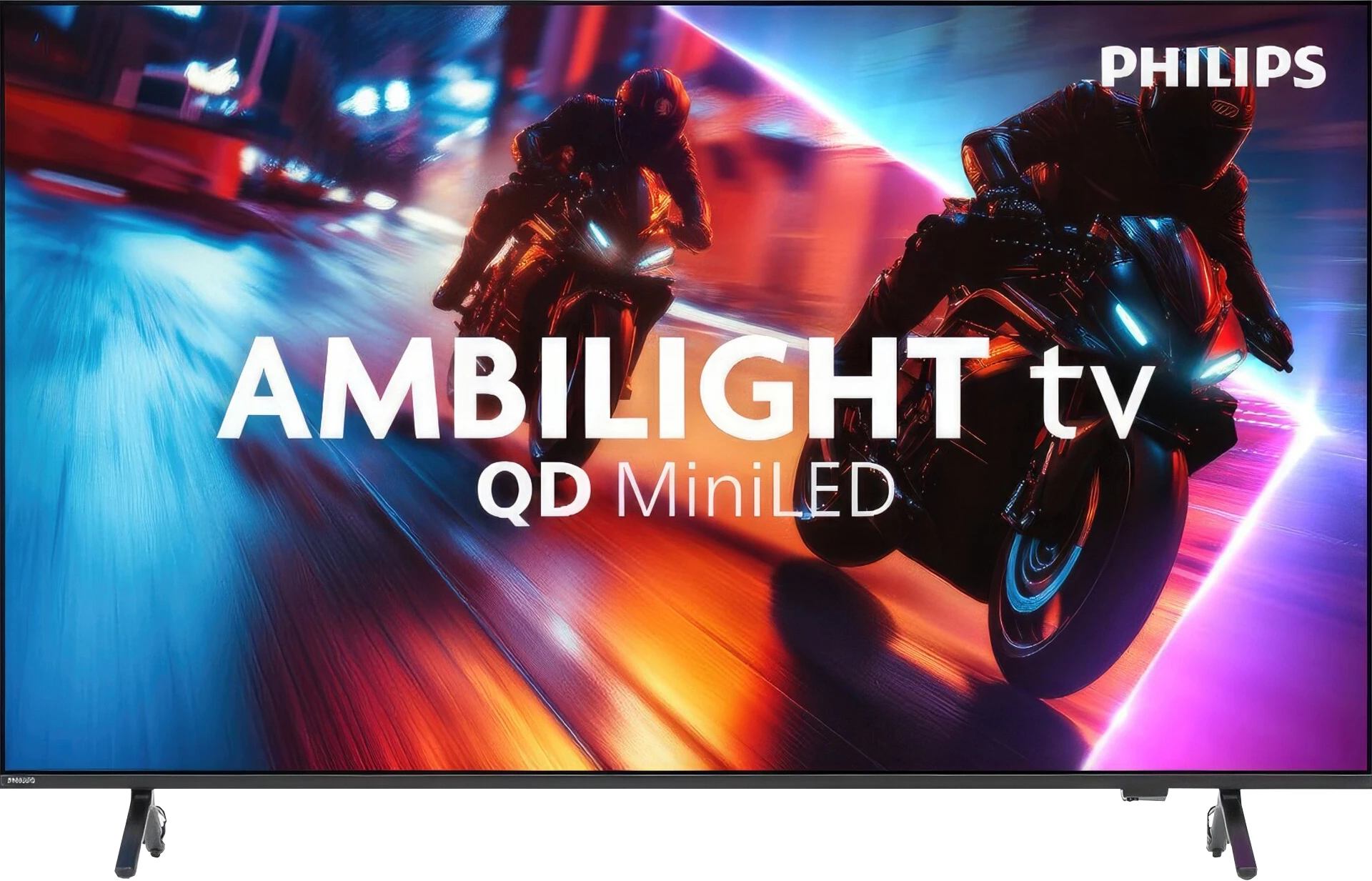
Panel type: LCD VA
Resolution: 3840x2160
System: Tizen
Model year: 2024
Complete the survey to find out the result

Panel type: LCD VA
Resolution: 3840x2160
System: Titan OS
Model year: 2025
Complete the survey to find out the result

Overall rating
7.4
6.5
Movies and series in UHD quality
6.7
6.4
Classic TV, YouTube
6.8
6.8
Sports broadcasts (TV and apps)
6.7
6.8
Gaming on console
8.9
8.5
TV as a computer monitor
7.6
4.0
Watching in bright light
7.3
5.5
Utility functions
7.4
5.5
Apps
8.7
6.7
Sound quality
7.0
6.2
Complete the survey to find out what fits your preferences
Advantages
Nice contrast - Miniled backlighting
Very good for gamers - 120Hz, 4xHDMI 2.1, low input lag
Tizen operating system with SmartThings and AirPlay support – wide integration and flexibility
Very high brightness 825 cd/m² – good performance in bright rooms
Pleasant sound with noticeable bass
Solid black and high contrast thanks to mini-LED backlighting
HDR brightness reaching 700–800 nits in real movie scenes
Support for multiple HDR formats including Dolby Vision and HDR10+
Ambilight – an element that adds atmosphere, especially in the evening
A lot of supported audio formats: DTS:X, Dolby Atmos, Dolby True HD 7.1
144 Hz panel with support for VRR, ALLM, and Dolby Vision Gaming
Loud sound (up to 88 dB)
Illuminated remote
Disadvantages
No recording feature
Limited support for multimedia formats, no DTS audio format
Titan OS is quite underdeveloped – there are significant errors and missing features in the applications
Few user-friendly features
Hybrid infrared remote
Issues with the smoothness of tonal transitions in dark scenes
The television is not suitable (aside from gaming) for working with a PC – strong dithering and poor readability of fonts, especially coloured ones and on dark backgrounds
Our verdict
Philips MLED920 is a natural continuation of last year’s PML9000 model, but it’s not a rehash. It’s clear that the manufacturer has done their homework – primarily, the local dimming algorithms have been improved, which last year could really spoil the viewing experience. Now, black levels and contrast are definitely better, and combined with Dolby Vision here, even HDR content looks quite decent. The picture can sometimes shine where it should, and it doesn’t strain the eyes in more challenging scenes. Undoubtedly, the greatest asset of the MLED920 is its unique Ambilight system. The three-sided backlighting can give films and games a whole new atmosphere – it’s as if the screen is extending beyond its boundaries, and the whole room becomes part of the viewing experience. This is something that will be appreciated not only by movie buffs but also by gamers, who, in addition to the lights, get a full set of features typical of modern gaming TVs: 144 Hz, VRR, ALLM, and Dolby Vision Gaming. In this regard, Philips has a lot to offer. But. Well, there’s a big but – this is where we reach the most difficult part of this verdict – it’s still a dual-purpose device. On one hand, we have strong picture quality and the unique Ambilight feature, on the other, there are hardware limitations that are hard to ignore. Titan OS in its current form is a big hindrance, full of bugs and shortcomings that make the TV lag behind the competition. Added to this is the price, which is by no means low for the features offered. Therefore, it’s hard to recommend it unequivocally to everyone. However, if you’re looking for Philips' brightest screen at a reasonable price, with Ambilight, a full set of features for gamers, and basic apps – the MLED920 will be quite a good choice.
TV appearance





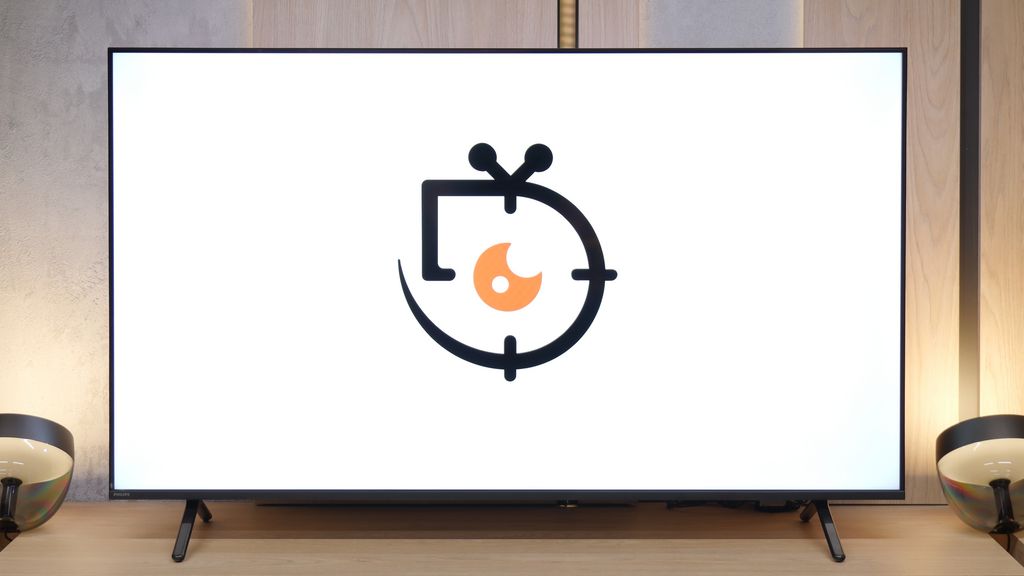
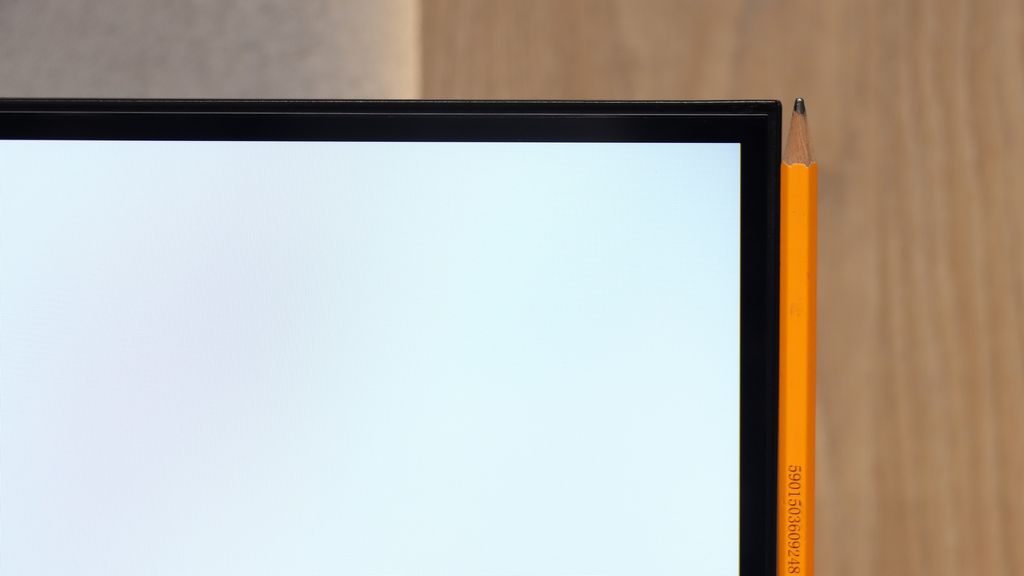
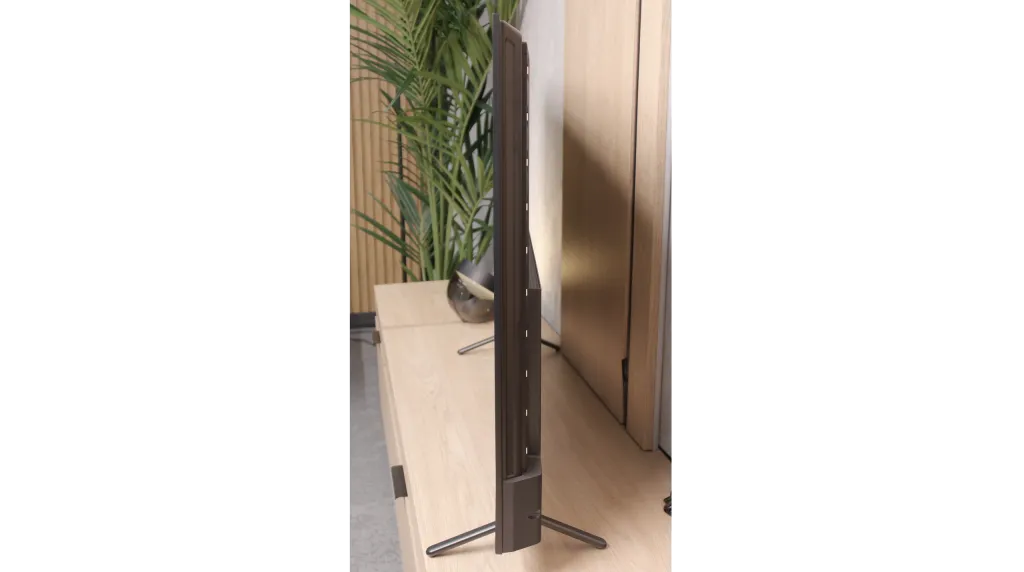
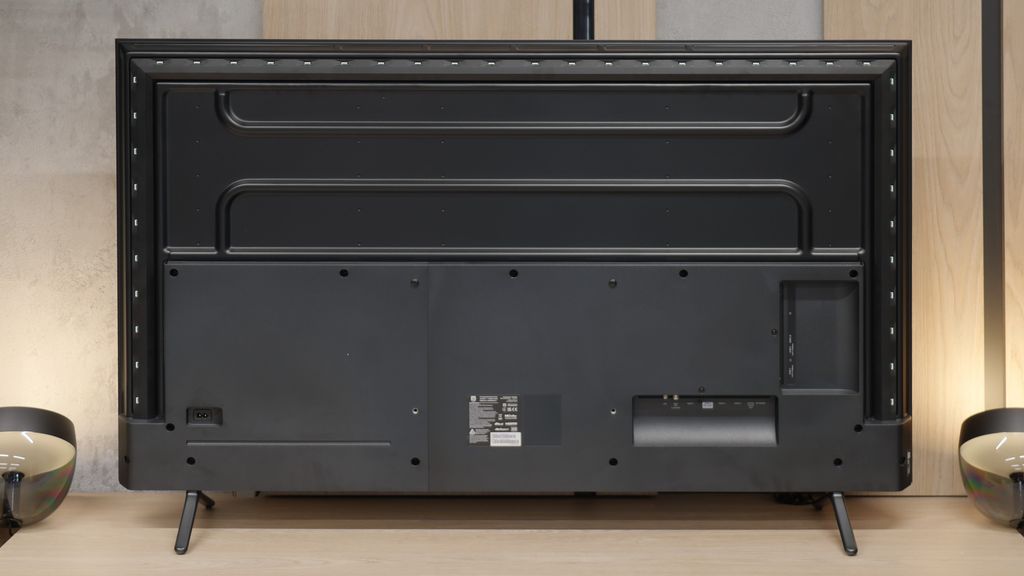
Contrast and black detail
7.6/10
7.9/10
Local dimming function: Yes, number of zones: 120 (12 x 10)
Local dimming function: Yes, number of zones: 144 (12 x 12)
Contrast:

Result
107,750:1

Result
27,100:1

Result
62,500:1

Result
8,750:1

Result
4,950:1

Result
298,900:1

Result
38,500:1

Result
23,950:1

Result
16,850:1

Result
8,000:1
Halo effect and black detail visibility:

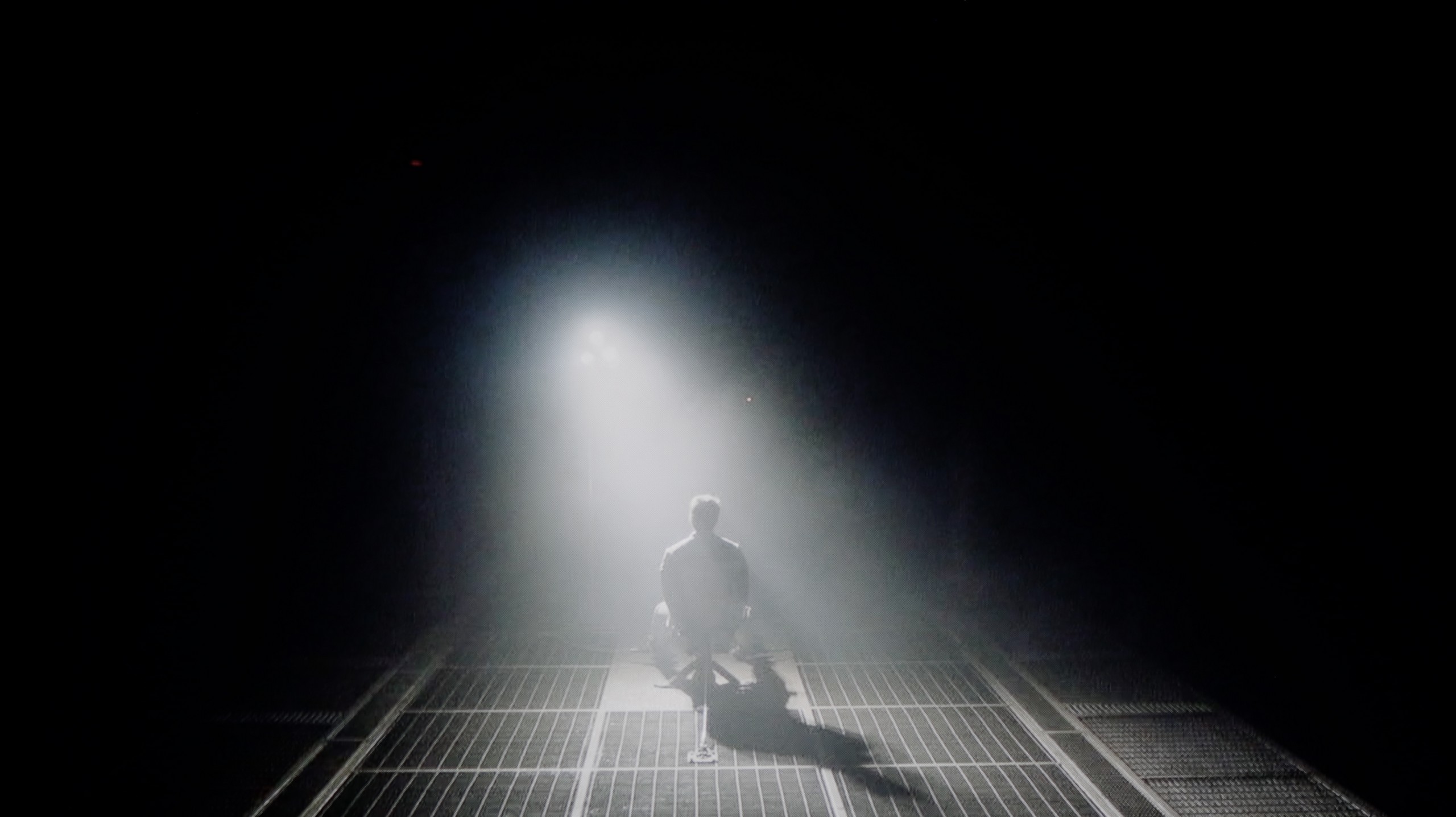
Samsung QN85D for 2024 is the first model from the NeoQLED series to use a VA panel, offering significantly better blacks than IPS/ADS technologies. The 55-inch version has 160 dimming zones, which may not be an impressive number compared to competing models from China. In larger sizes, the number of zones is greater, which naturally translates to better contrast. The contrast results are good, but certain limitations are evident.
With smaller elements on the screen, the limited number of zones causes issues – the TV either tries to maintain a high brightness level, resulting in a halo effect around objects, or it dims too much, as observed in the test scene from the Pioneer disc. Additionally, in the same scene where the TV showcased its highest capabilities (Oblivion) in contrast, it also has significant problems with light separation. You can see how the TV struggles to maintain the best black at the cost of detail in the whites. You can't have it all. Both of these effects impact the perception of contrast, making the performance weaker in more challenging conditions. However, compared to TVs without local dimming technology, the results are very positive and can be surprising.
Philips MLED920 in the 55-inch version that we had the opportunity to test uses a high-contrast VA panel. The panel itself is one thing, but the real standout feature of this model is the mini-LED backlighting. This largely determines how black and contrast look – and it must be said that Philips has taken a big step forward compared to the models from 2024, where the local dimming algorithms performed just average. In this new version, it is significantly better, and the contrast presented by the MLED920 can truly surprise in a positive way. At times, it even approaches the level known from the best LCD TVs on the market – blacks can be deep, the image gains a three-dimensional quality, and viewing experiences in a dark room leave a great impression. Of course, as with any mini-LED TV, this is not an image completely free of compromises. With a large number of small elements on the screen, the local dimming algorithms can sometimes get confused – at times dimming details more than we would like and other times brightening the background, resulting in slight, light blue halos around objects (the so-called halo effect). Despite these imperfections, we must emphasize that black and contrast are truly strengths of the Philips MLED920 and definitely one of the reasons to consider it in the mid-range segment.
HDR effect quality
5.6/10
5/10
Luminance measurements in HDR:

Result
999 nit

Result
335 nit

Result
562 nit

Result
182 nit

Result
855 nit

Result
722 nit

Result
177 nit

Result
775 nit

Result
131 nit

Result
677 nit
Scene from the movie “Pan” (about 2800 nits)


Scene from the movie “Billy Lynn” (about 1100 nits)


Static HDR10


Dynamic: HDR10+
Dynamic: Dolby Vision


HDR luminance chart:
Philips MLED920 / MLED910
HDR luminance
Samsung Neo QLED QN85D / QNX1D
HDR luminance
Samsung QN85D leaves us with mixed feelings regarding HDR quality. It can shine in synthetic luminance tests, reaching even 1000 nits – which makes scenes like those from 'The Meg' or the start of 'Life of Pi', where the screen is all bright, look truly impressive. However, in practice, the device has its limitations – especially when smaller bright elements appear on the screen. In such moments, brightness noticeably drops, and the HDR effect loses its punch. At brightness levels around 200-300 nits, the magic of HDR simply fades away, not delivering spectacular effects. However, it’s not that the television completely disappoints – coverage of the DCI-P3 colour gamut at 95% is quite decent, although it doesn’t stand out against the best competitors. Colours are well-rendered, but it's clear that HDR could make a bigger impression if brightness could be better controlled.
Philips MLED920 in our measurements in static tests even reached around 900 nits, which for a mid-range model is quite an impressive result. In practice, this translates to a lot of satisfaction during viewing – in scenes rich in bright light, such as the first, third, or fifth test patterns, the screen was able to generate around 700 nits, which is sufficient to feel the real "HDR effect". However, it cannot be denied that the limited number of backlight zones and the typical mini-LED compromises in dimming algorithms reveal their flaws in more demanding scenes. In sequences with small light sources – like the moon or a scene from the film Sicario 2 – the television clearly prioritises maintaining deeper blacks at the expense of the brightness of these small elements. For most viewers, this is still a reasonable compromise, as the dark background looks much better, although it should be noted that the details themselves may not dazzle with intensity. The question of colours also leaves a bit to be desired. Although the employed PFS filter (the equivalent of quantum dots known from QLEDs) does its job and the colours appear quite vibrant, the coverage of the DCI-P3 colour space reaches "only" 90%. In everyday viewing, this will be sufficient, but in extremely colourful productions – like the latest Disney animations – one can notice that some tones are not as vivid as they could be in other constructions.
Factory color reproduction
6.3/10
5/10


Factory Mode
After calibration


Factory Mode
After calibration
Samsung QN85D TV has been tested in the best available mode – Filmmaker. While one might expect its name suggests a mode perfectly suited for films, unfortunately, it has several significant issues.
When it comes to white balance for HD content, there is a noticeable dominance of red and blue, which makes the entire image take on pinkish hues – this is also confirmed by Colour Checker tests. This effect disturbs the naturalness of skin tones and many other elements, which is particularly evident in more demanding scenes. Initially, the white balance for 4K HDR content seems correct, but at the end of the graph, there is a significant spike in blue hues, affecting the final image quality and making the colours appear unnatural.
The gamma brightness characteristic is also not ideal – although it generally stays close to the reference value, there is a slight drop below 2.4, which can impact the perceived depth of shadows. The EOTF curve responsible for 4K content does not perform any better. There is a clear boost compared to the reference curve, leading to excessive brightness in some areas, thus losing the cinematic quality that the Filmmaker mode should provide. While it might initially seem that the effect is cinematic, unfortunately, the number of errors in colour and brightness reproduction is too significant to call it flawless.
Like every Philips TV we've tested, the MLED920 was primarily assessed in Filmmaker mode – the so-called "most honest" mode, designed for films and to faithfully convey the intentions of the creators. Indeed, in terms of colour accuracy, it performs best among all the modes available on the TV, but it is not without flaws. The first thing that stands out is the white balance. The image has a slight tendency towards purple-pink tones, giving it a somewhat unnatural character. However, an even bigger problem turned out to be what we mentioned earlier – image clipping. Just looking at the gamma or EOTF charts reveals that the line deviates significantly from the norm, dropping below a value of 1.8. In practice, this means "bleeding" of the brightest whites, where the image becomes almost milky. Fortunately, most of these issues can be corrected – the MLED920 responds to calibration, and with a few adjustments, image quality can be significantly improved.
Color reproduction after calibration
7.9/10
7.5/10

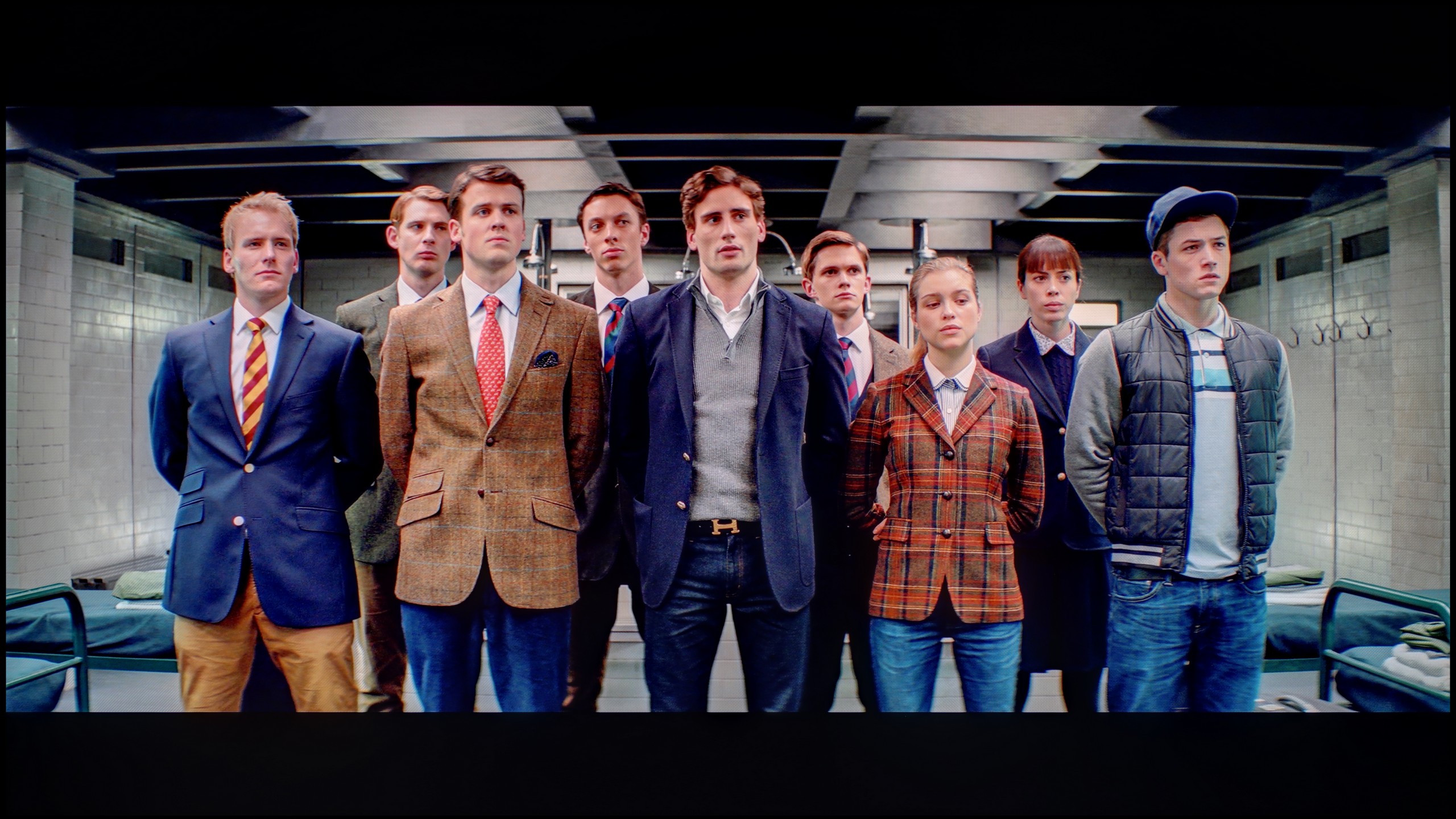

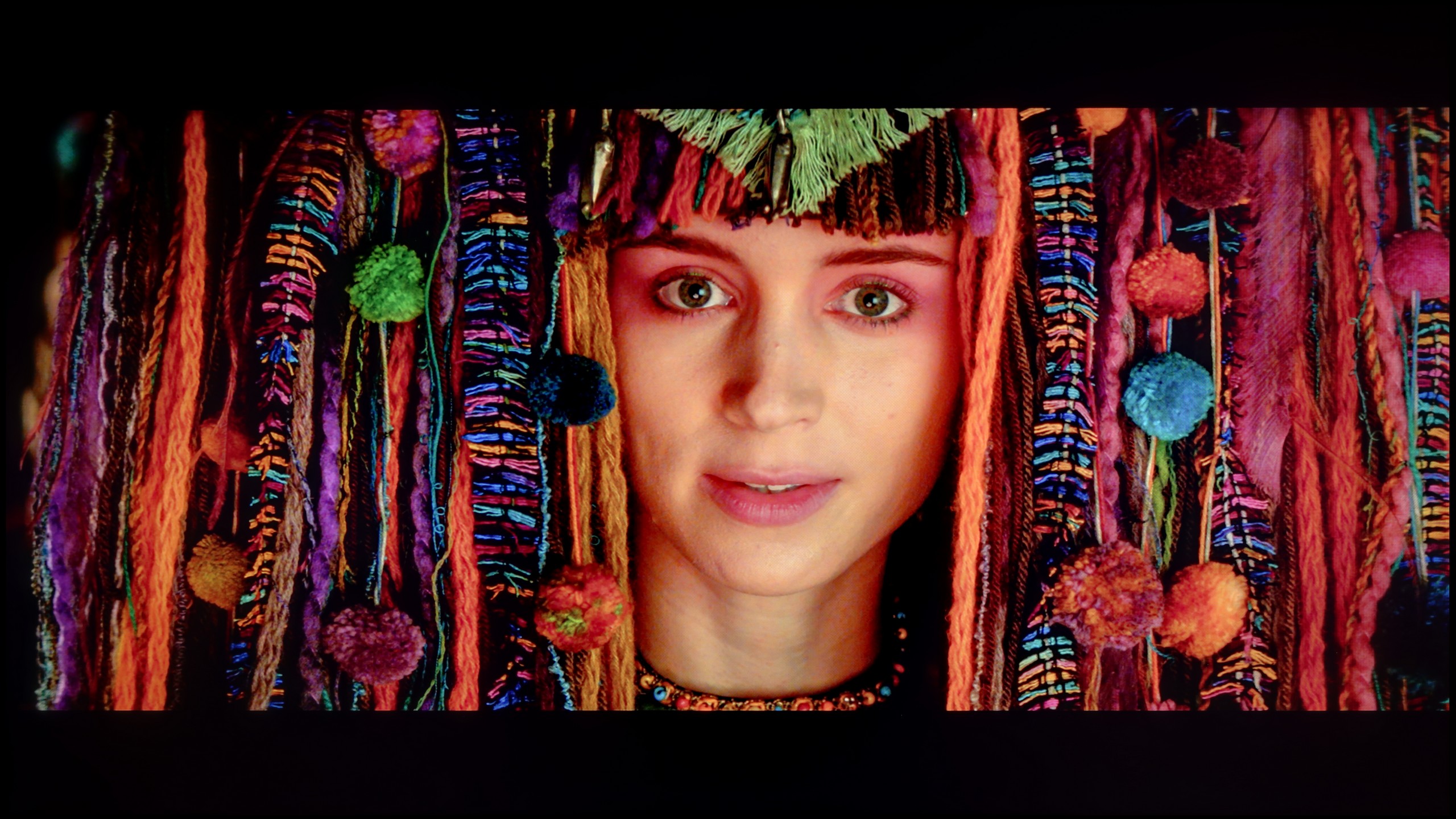
After professional calibration of the Filmmaker mode on the Samsung QN85D television, a significant improvement is noticeable, especially for HD/SDR content. The white balance has been completely free of major errors, and the brightness characteristics for this type of content have been significantly adjusted, allowing for a more natural and realistic image. Television, YouTube films, and other HD materials now look much better, with appropriately balanced colours and without the exaggerated hues that previously marred the experience.
However, the biggest issues arise with 4K HDR content. Despite the calibration, it's hard to speak of significant improvement in white balance here – the differences are cosmetic rather than essential. Brightness, governed by the EOTF curve, seems to be set according to the reference level in synthetic tests at first glance, but has its limitations during actual viewing in films. When analysing the EOTF curve in real film scenes, it becomes clear that the television struggles to maintain consistency in brightness. The effect is that mixed scenes still have their darkest elements boosted, leading to exaggerated contrasts, and completely dark scenes remain too dark, which negatively affects the visibility of details.
After calibration, we managed to largely tame the white balance – to the extent that the average viewer will not be able to detect colour inaccuracies. The characteristic pink-purple glow that previously disrupted the naturalness of the image has also disappeared. The colour palette has been organised, and the colours appear more cohesive and neutral. The gamma in SDR content looks really good after calibration – there’s no sign of the earlier “bleeding” effect in bright scenes. The image has become more contrasty and free from the milky effect that previously severely affected the viewing experience. In the case of HDR content, the improvement is also noticeable, although here it is still evident that the television goes “its own way”. The EOTF curve cannot be fully adjusted, as Philips simply does not offer tools for precise control of this parameter in its settings. In many films, the television still exposes the image “in its own way”. Despite these limitations, calibration has brought a lot of good – the majority of colour inaccuracies have been minimised and the overall image balance has significantly improved. However, one must remember that certain barriers arise from the very hardware construction and simply cannot be overcome.
Smoothness of tonal transitions
7.6/10
6.5/10





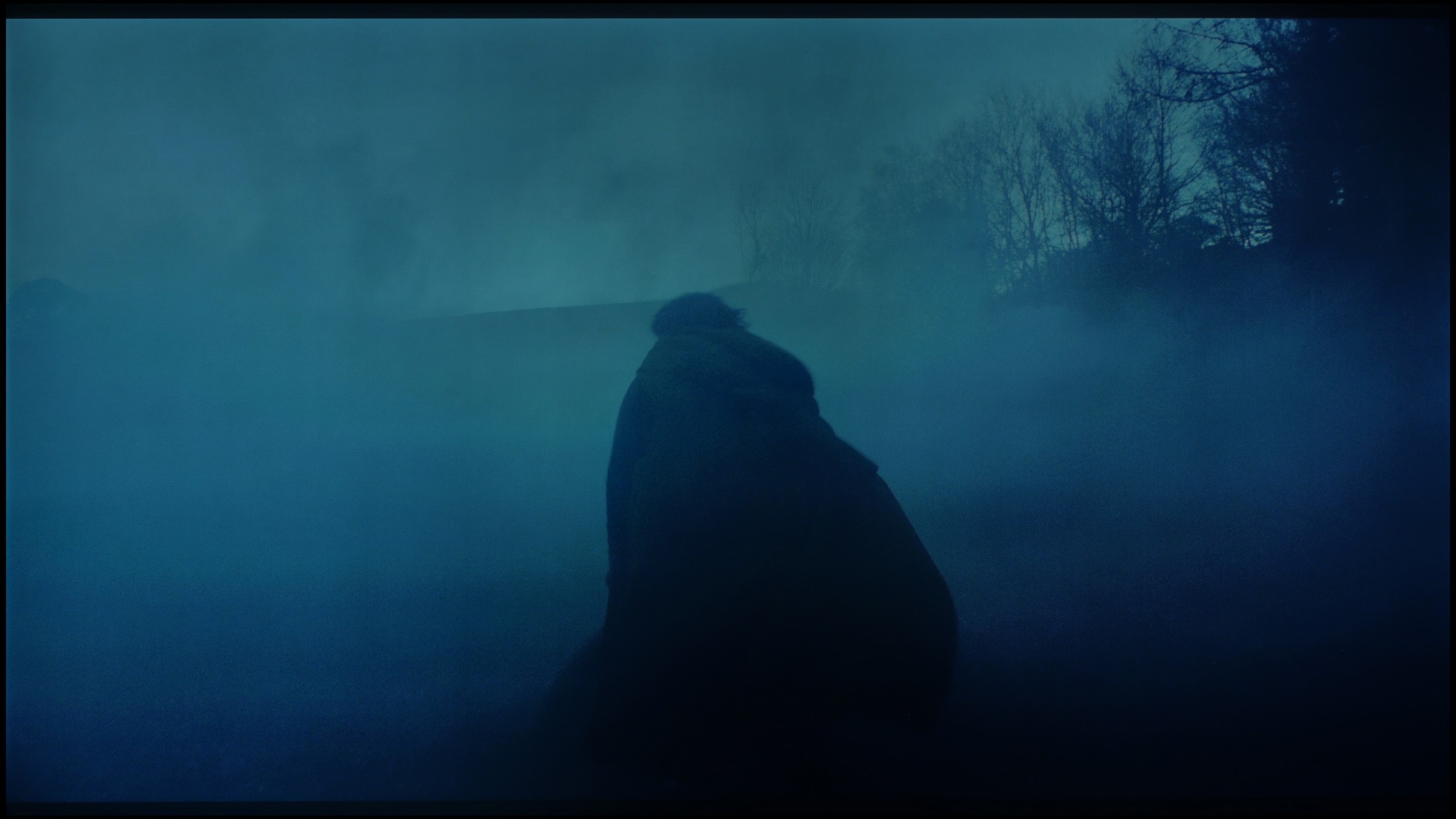






When it comes to tonal transition fluidity on the Samsung QN85D television, it’s generally very good. The tonal transitions are smooth, and there are no significant artifacts. However, more demanding users may notice some issues in certain scenes. For example, when blending darker colours, like in the scene with the red sea, subtle shortcomings can be observed. Similarly, in the case of lighter colours – the scene from the film 'The Martian' shows slight gradation issues, leading to subtle but noticeable transitions between shades. Despite these minor shortcomings, most users should be satisfied. The results are of a high standard and in most cases provide smooth, natural transitions between colours.
The fluidity of tonal transitions in the Philips MLED920 is not its strongest suit. In our tests, we quickly noticed that the television has noticeable issues in darker scenes – examples include segments from the film The Green Knight or test grey palettes. There, you can see characteristic banding of colours and too harsh transitions between shades, which can be quite noticeable in productions with a darker aesthetic. Fortunately, the situation looks better in brighter scenes – there, the image presents smoothly and without significant artifacts.
Image scaling and smoothness of tonal transitions
7/10
7/10
Smooth transition function

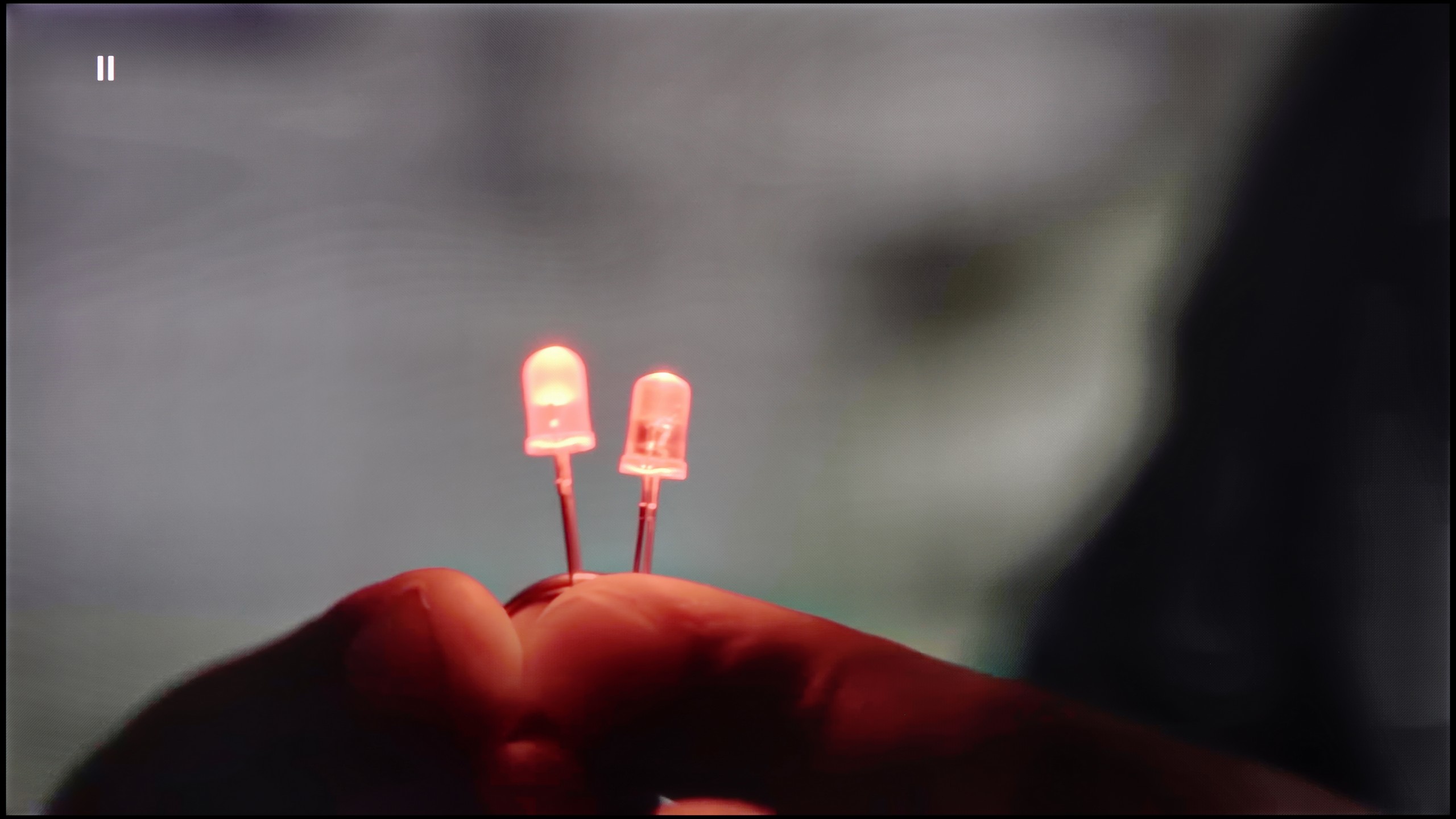
Image without overscan on the SD signal


When checking the fluidity of tonal transitions in low-resolution materials on the Samsung QN85D television, it’s worth noting the noise reduction feature, which significantly improves problematic tonal transitions. On the other hand, this feature also has its downsides – it removes film grain, which is an important element of many productions, giving them authenticity, and it can also soften the image. This may appeal to those who prefer a smoother picture; however, for lovers of the authentic look of films, using this feature should be considered carefully.
Regarding image scaling, the television performs very well. The model's figure is presented correctly, without noticeable distortions, and the branches in the background do not have excessive artificial sharpness, which is often a problem when scaling lower resolution materials. The high capabilities of the image processor are evident here, which can effectively process lower quality materials, ensuring good final quality.
The manufacturer has equipped this model with several features that improve signal quality, and although we usually approach such “enhancers” with caution, here they prove to be really helpful. The key option is called “distortion reduction” – it works best at a medium level because, on one hand, it effectively smooths out unwanted steps and colour transitions, and on the other, it doesn’t excessively cut details, meaning the image still looks natural.
It’s a bit worse when it comes to upscaling. Lower quality materials – such as the test video with the model – appeared soft and lacking sharpness. Of course, it can be partially adjusted with the sharpness slider in the menu, but the result still falls short compared to what competitors offer at a similar price. Philips still needs to work on this aspect because, in light of the successful improvement of tonal transitions, the upscaling simply comes off weak.
Blur and motion smoothness
7.5/10
7.7/10

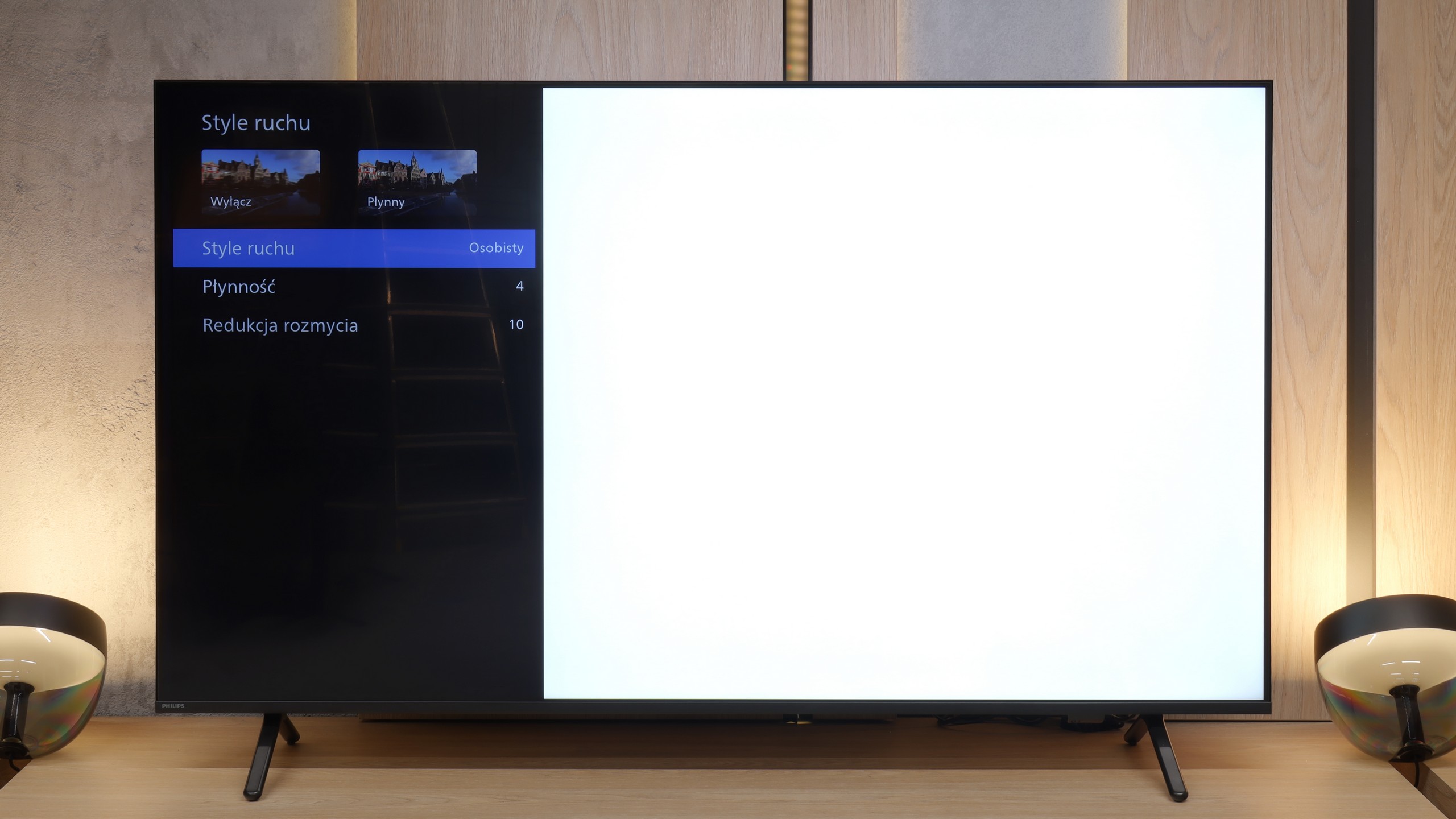
Blur (native resolution, maximum refresh rate):



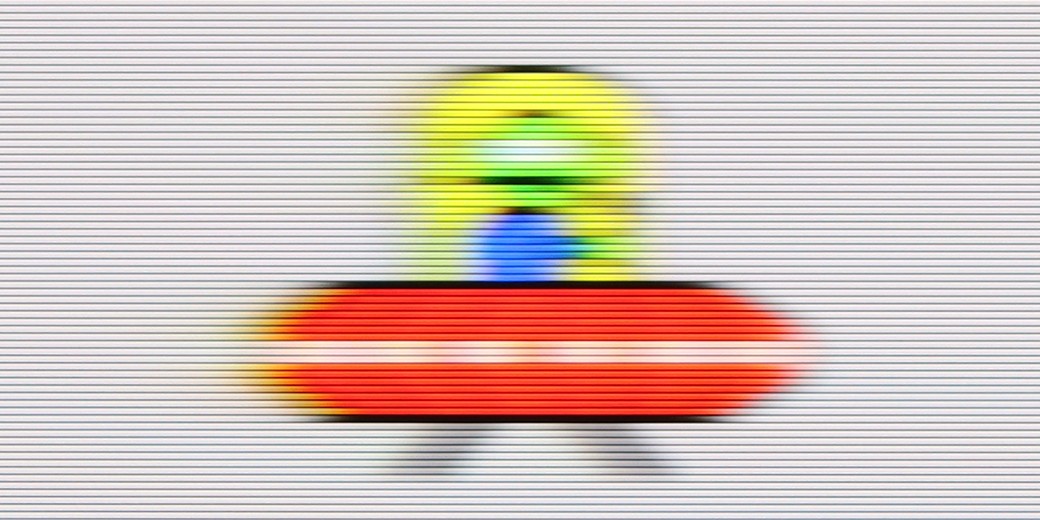
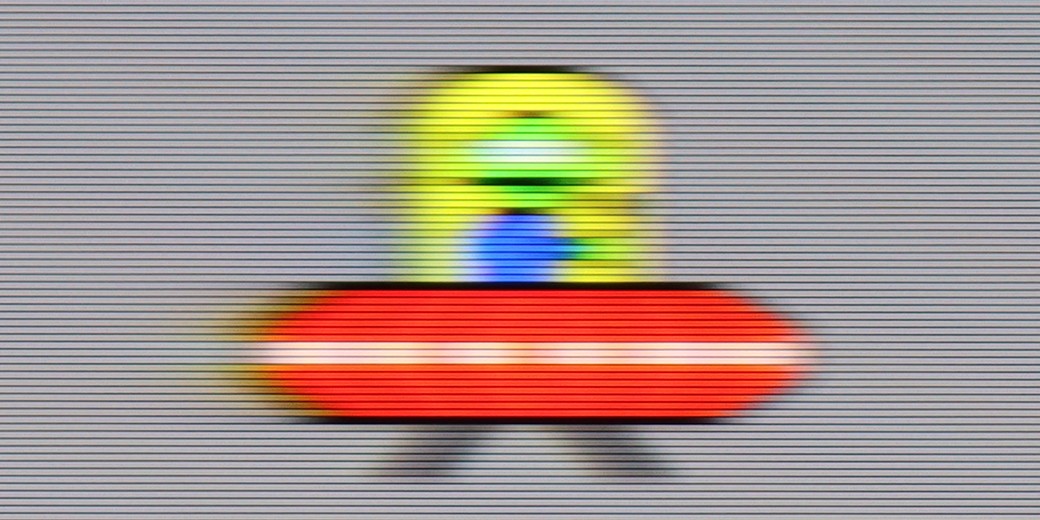

Smużenie ():
Smużenie (4K@144Hz):

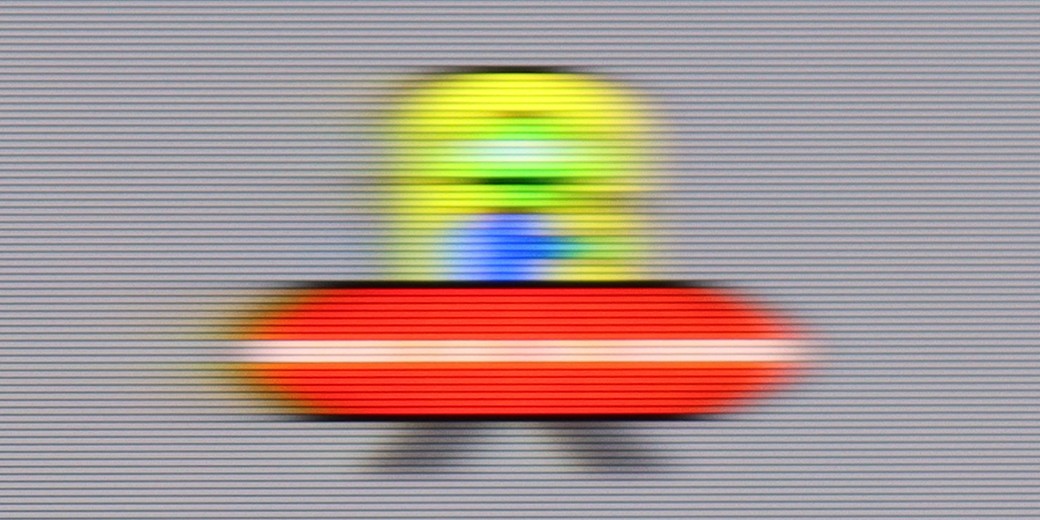

Samsung QN85D TV is equipped with a 120 Hz refresh rate panel, which should satisfy both gamers and sports enthusiasts by offering a smooth and dynamic image. There are options to enhance fluidity, such as the blur and judder reduction feature, which allows precise motion fluidity adjustments on a 10-point scale. The blur reduction increases the sharpness of fast-moving objects, making action scenes more readable, while judder reduction smooths out motion, eliminating the “judder” effect. Ghosting is generally well controlled, though minor imperfections can be visible in more demanding scenes, especially when an object moves against a dark background. Additionally, the TV offers a BFI (Black Frame Insertion) feature at a 60 Hz refresh rate, which can significantly improve motion fluidity experience, although at the cost of image flicker, which might be bothersome for some users.
Philips MLED920 features a 144 Hz panel, which immediately suggests that we shouldn’t complain about motion smoothness. And indeed – for a VA panel, the motion blur is relatively low here, and while you can sometimes notice slight issues on darker backgrounds, they’re not something that will catch the eye of most people during regular viewing.
A big plus is also the presence of a motion smoother called “Motion Style.” It allows you to adjust the smoothness to your own preferences – if someone prefers a more “theatrical,” almost television-like character of the image, they can increase the sliders, and if they want to maintain the natural “judders” of a cinematic frame, they just need to set lower values. This way, everyone can find a happy medium.
Console compatibility and gaming features
9.5/10
9.8/10
- ALLM
- VRR
- VRR range48 - 120Hz48 - 144Hz
- Dolby Vision Game Mode
- Correct implementation of HGIG
- 1080p@120Hz
- 1440p@120Hz
- 4K@120Hz
- Game bar

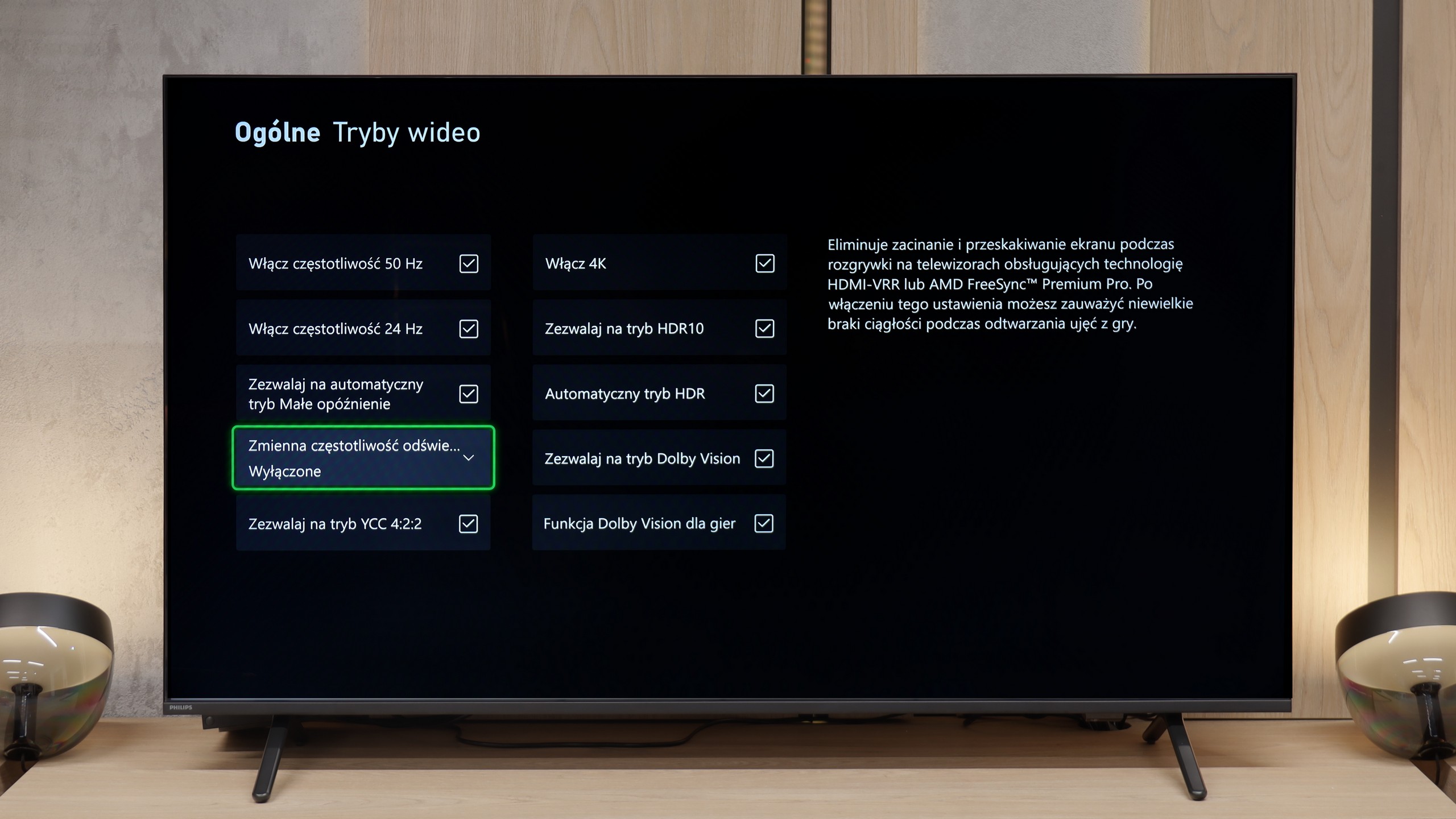

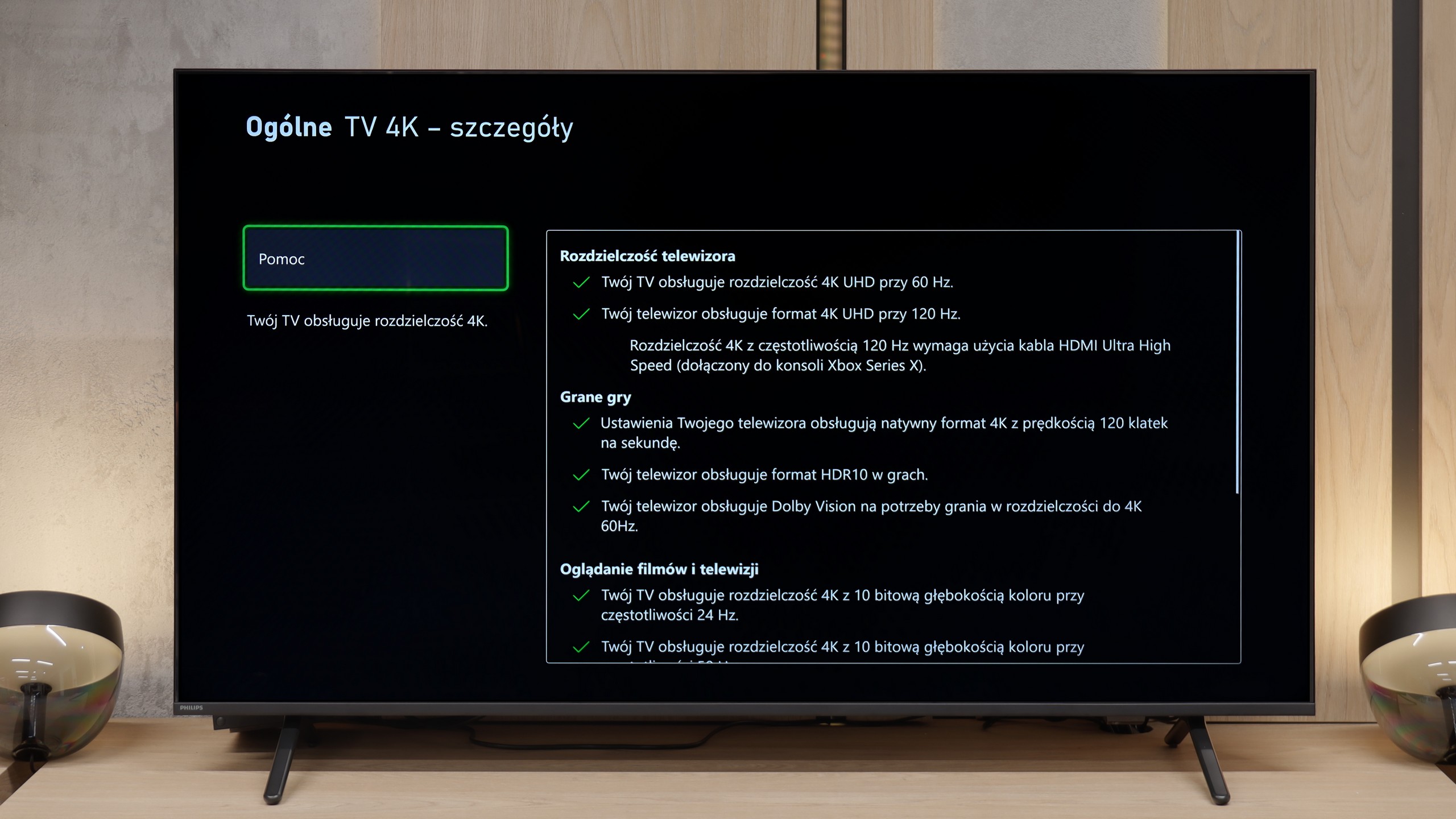

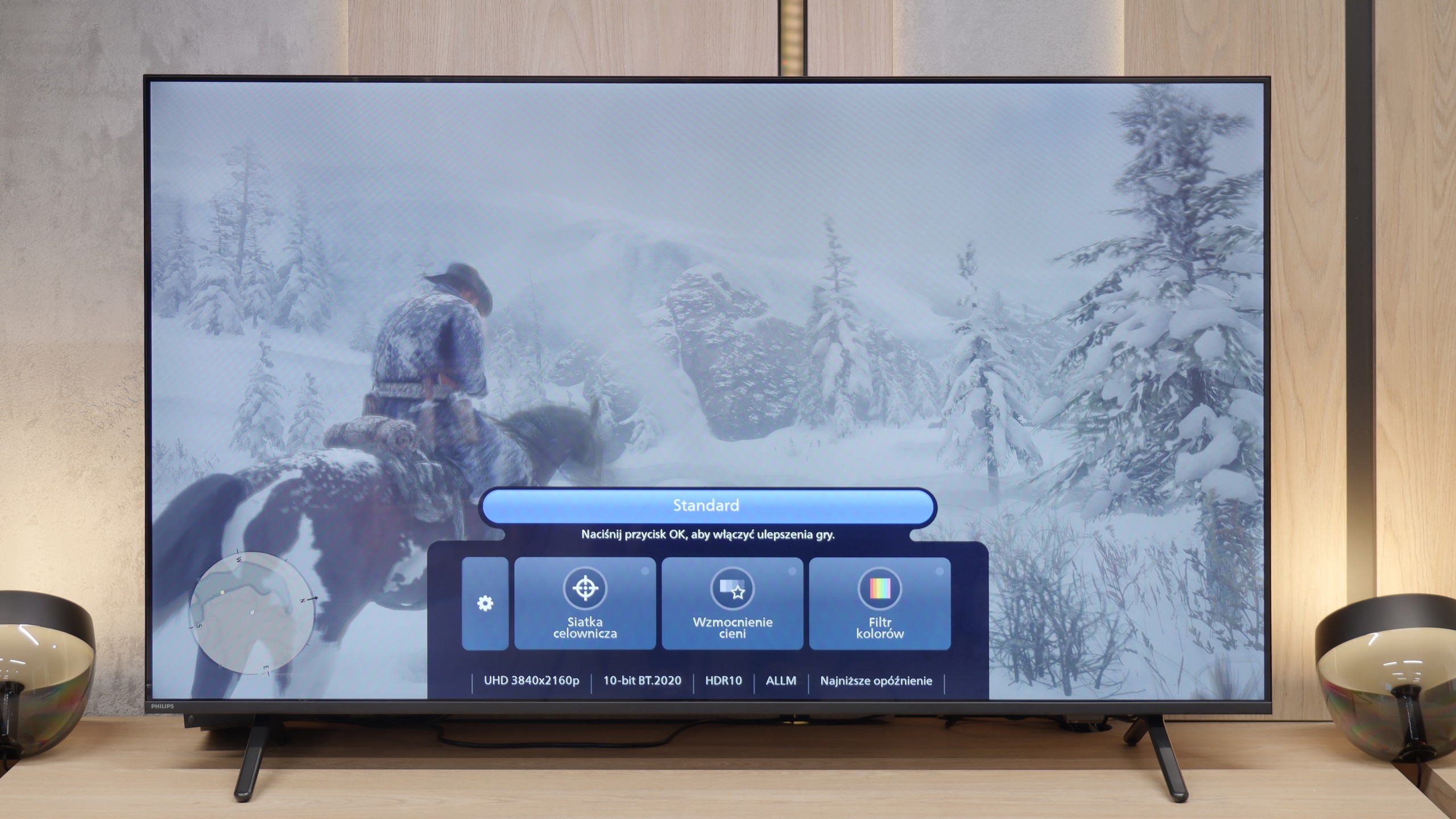

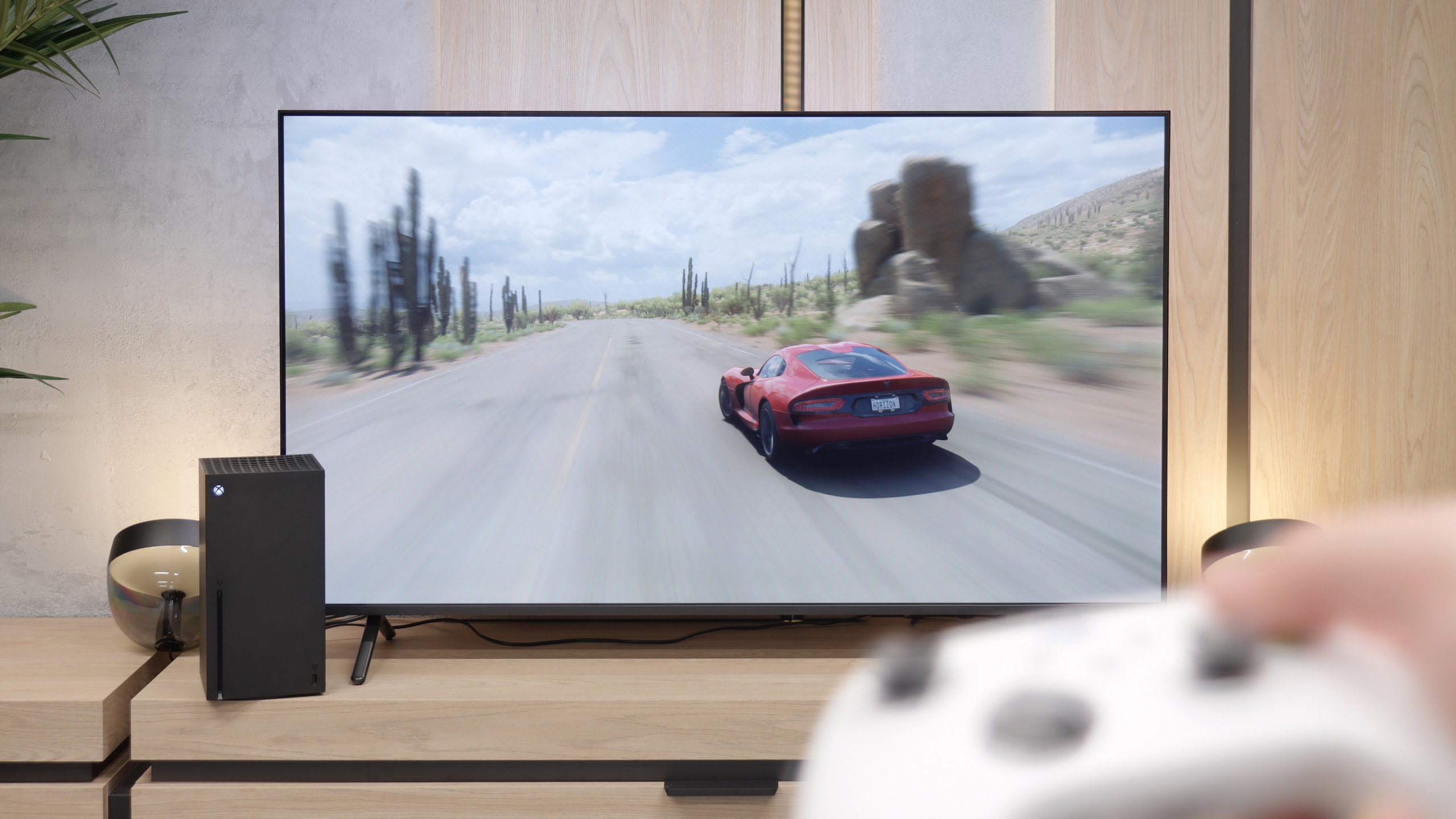
The Samsung QN85D television is an excellent choice for gamers, offering a wide range of features that enhance the gaming experience and make it even more exciting. With a 120 Hz refresh rate panel, the image is incredibly smooth, which is crucial during dynamic scenes in action games. The television also boasts low input lag, allowing for nearly instant reactions to player commands, which translates into better control over characters and events on the screen.
In addition, the QN85D Samsung supports VRR (Variable Refresh Rate) and ALLM (Auto Low Latency Mode) technologies, which optimise image smoothness and reduce delays by automatically adjusting the television to the needs of gamers. Moreover, the Xbox app allows for cloud gaming without the need for a console, which is a big plus for those who want to enjoy their favourite titles without additional hardware – a feature that sets Samsung televisions apart.
The Auto Motion Plus Game feature is another aspect worth highlighting. This motion smoothing technology creates the illusion of more frames per second – as a result, games at 30 fps appear smoother, resembling gameplay at 45 fps, while games at 60 Hz come closer to 90 Hz. Most importantly, this feature does not introduce significant lag, ensuring that gaming comfort is not compromised. This allows gamers to enjoy a smoother image without compromising responsiveness.
For gamers, the Philips MLED920 is truly a complete tool. The manufacturer has taken care of everything that is now considered standard in televisions for consoles and PCs. It has ALLM, so the console automatically switches the screen to game mode, there’s VRR and a 144 Hz refresh rate that ensures smooth gameplay even in fast-paced titles. All key HDR formats are supported – including HGiG and Dolby Vision Gaming for Xbox – which means that regardless of what you’re playing and on which console, the television will be able to extract the maximum potential from the image. In everyday gaming, the Game Bar proves useful too – a relatively simple implementation by Philips, but a functional panel where you can quickly check image parameters, enable VRR, or adjust details without leaving the game. It’s not as elaborate as the competition, but it does its job without any complaints. And finally, something that sets Philips apart from the competition – Ambilight. The three-sided LED backlighting can make a huge impression in games, especially in the evening. It’s also a way to slightly 'expand' the screen and create a greater sense of immersion. And since coloured LEDs have recently become almost an essential element of a gamer’s room, the MLED920 fits perfectly into this trend.
Input lag
9.9/10
9.6/10
SDR
HDR
Dolby Vision
Samsung QN85D impresses when it comes to input lag value. The television achieves outstanding results – below 15 ms for 60 Hz content and around 10 ms for 120 Hz content. This allows gamers to enjoy instantaneous responses to their actions, especially in dynamic games where every millisecond counts. Such low input lag makes gameplay more responsive and natural, enhancing the overall experience while playing.
The input lag on the Philips MLED920 is really very good – in 120 Hz mode, we measured values below 10 ms, which places this model among the absolute top of LCD TVs in terms of responsiveness. Even at 60 Hz, a result of around 18 ms is fully acceptable and won't interfere with any type of gameplay. One exception is the Dolby Vision mode at 60 frames, where the latency can increase to as much as 35 ms. This is a result that may be a bit glaring for esports players, but it must be stated honestly – for most so-called "casual gamers," it will be absolutely imperceptible. Especially since we're talking about values that still allow for comfortable gaming without major compromises.
Compatibility with PC
7.6/10
4/10

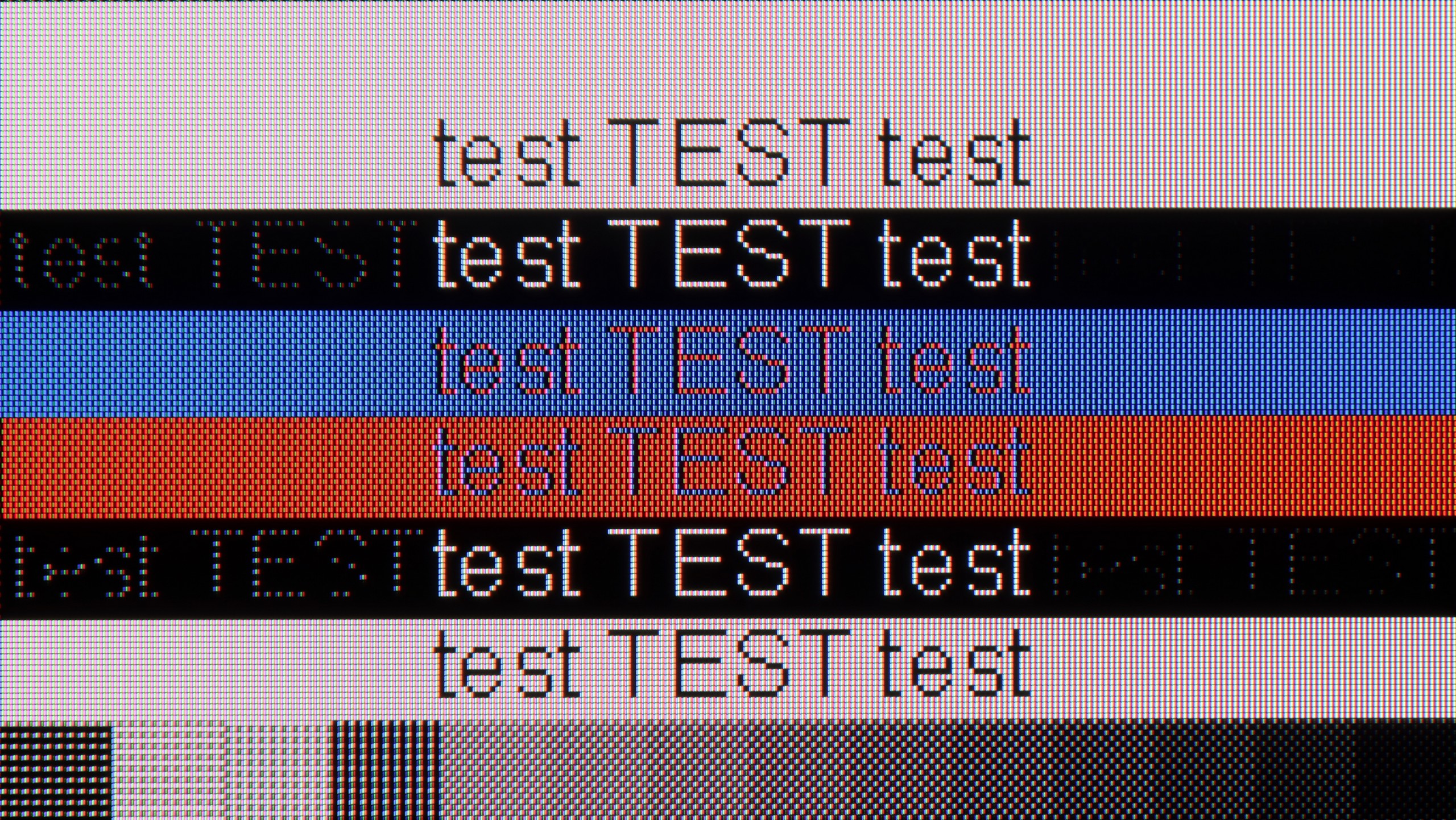
Samsung QN85D could be a good option as a computer monitor. Thanks to support for chroma 4:4:4 (available only in "Game" mode), text on the screen is clear and easy to read, which is crucial for those working with word documents or spreadsheets. A major advantage of this model is its exceptionally low input lag in "PC" mode – just 9 ms, which is really impressive and provides high fluidity and responsiveness, making it suitable for both work and gaming. However, there are some drawbacks. When displaying fonts on a dark background, an issue arises – when zooming in on an image, it can be seen that the horizontal lines are darker than the vertical ones. This is due to the fact that the sub-pixels in those areas do not light up fully, which may be a result of oversight on the manufacturer's part in optimising the algorithm responsible for displaying thin lines. As a result, the quality of text on a dark background is not ideal. Despite this, the television still remains a very good choice as a PC monitor, especially considering the low input lag and support for chroma 4:4:4.
When it comes to working with a PC, the Philips MLED920 evokes quite mixed feelings. On one hand, it looks impressive on paper – we have 144 Hz, support for G-Sync and FreeSync, so in terms of gaming on PC, the TV does not disappoint. Anyone looking for a large screen for computer games gets a solid package of features here. However, when we try to use it as a typical monitor for everyday work, its limitations quickly become apparent. The fonts do not look the best – there is noticeable strong dithering, coloured letters can be jagged, and with very dark text, there are even strange anomalies, as if the panel is losing thin lines and having trouble reproducing them correctly. In short: For PC gaming, yes. For any work and reading text: a definite no.
Viewing angles
2.9/10
3.2/10
The Samsung QN85D television, due to its VA panel, has quite poor viewing angles. When viewed from the side, colours lose their intensity, and the image becomes noticeably less contrasted. This is a typical drawback of VA panels, which offer significantly worse picture quality when viewed from wider angles. However, directly in front of the television, the situation looks much better – the VA panel then provides deep blacks and better contrast, which is a big plus if the television is mainly watched while sitting directly in front of the screen.
The viewing angles on the MLED920 are classic for VA type panels – even a slight tilt from the centre causes the image to start losing colours, contrast weakens, and the overall picture becomes quite flat and less appealing. There are no miracles here. So if you’re watching films with a larger group and everyone is sitting a bit to the side, this will be slightly noticeable. On the other hand, you get what you pay for: thanks to this panel, the MLED920 can display a much deeper black than TVs with IPS panels.
TV efficiency during daytime
7.3/10
5.5/10

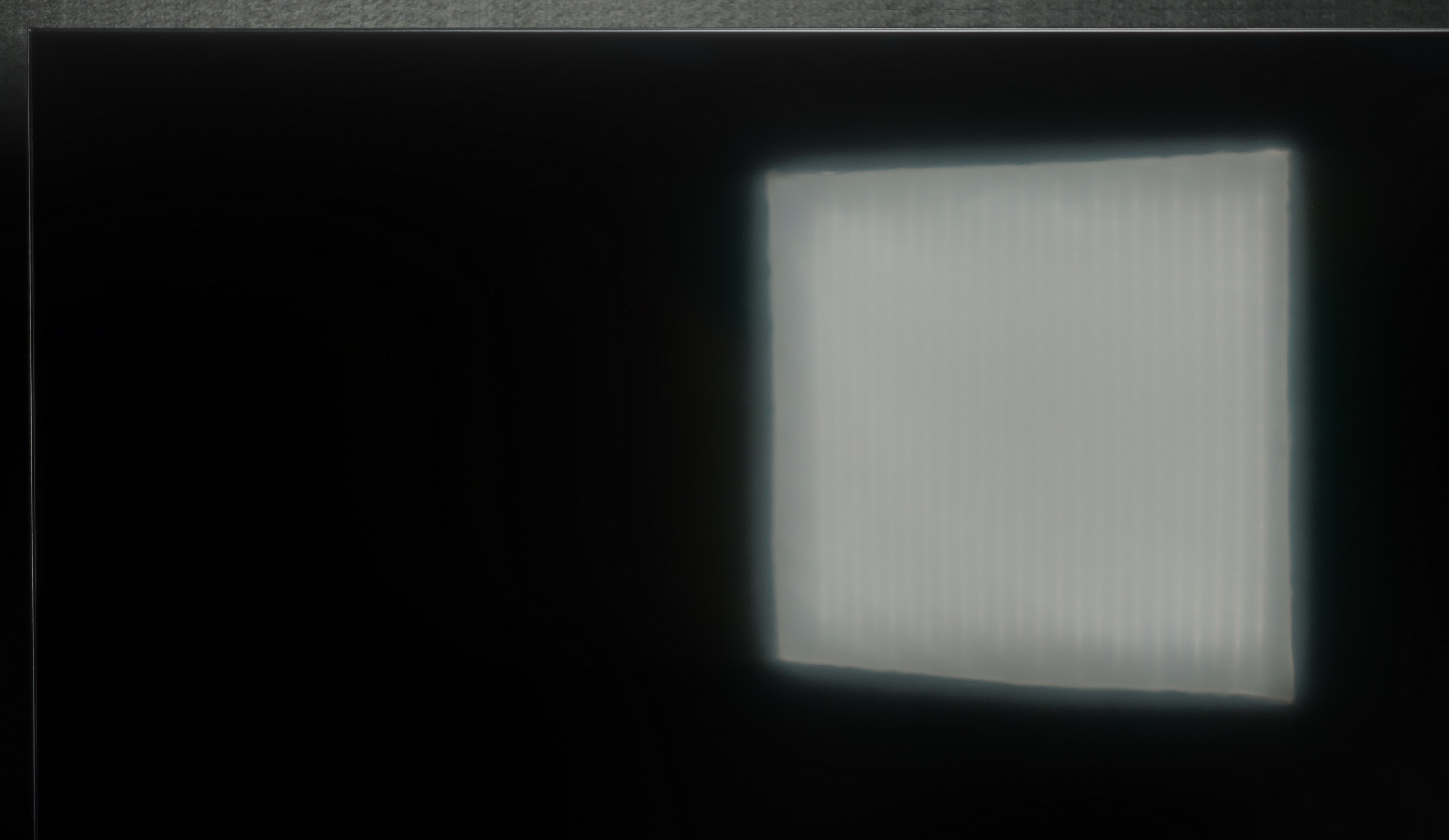

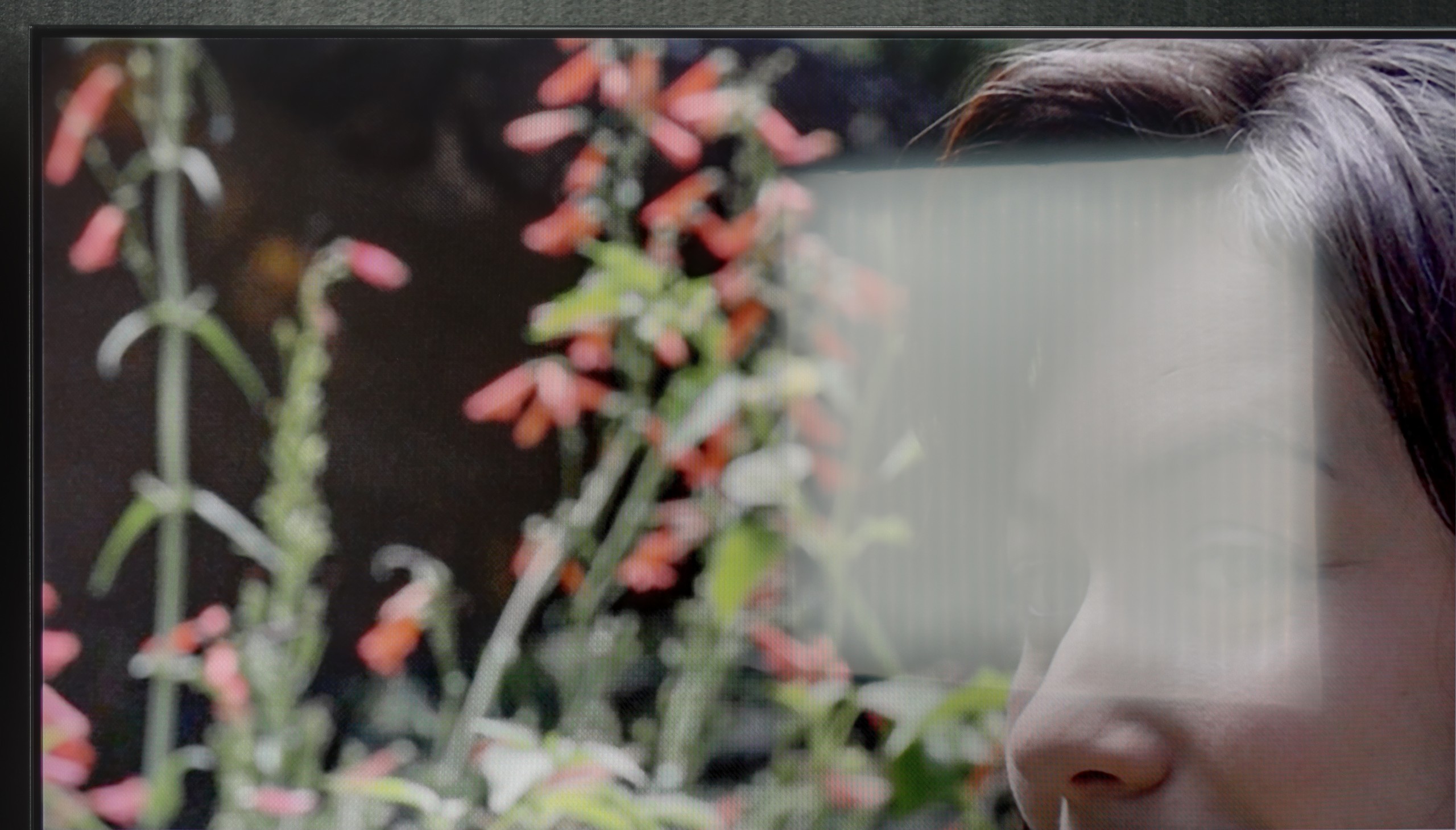
Matrix brightness
Average luminance SDR
Philips MLED920 / MLED910: 421 cd/m2
Samsung Neo QLED QN85D / QNX1D: 825 cd/m2
Samsung QN85D TV performs very well in bright daylight conditions. Although the satin panel moderately suppresses reflections, the brightness level of 825 cd/m² is truly impressive. Even in direct sunlight, the television handles itself very well, providing a clear and sharp image, and the largest external light sources do not pose a significant problem. This makes this model a good option for rooms with a lot of natural light.
Philips MLED920 performs quite well in everyday use. The satin finish on the panel effectively reduces reflections, and in most moderately sunny living rooms, it manages unwanted glare quite well. However, it's important to remember that this is not a TV that dazzles with brightness – the average value in SDR hovers around 450 nits. In very bright rooms, particularly with large south-facing windows, the screen doesn't always stand up to the intense daylight. In such situations, it's worth supporting it with even light curtains, so viewing comfort doesn't suffer too much.
Details about the matrix
Subpixel Structure:

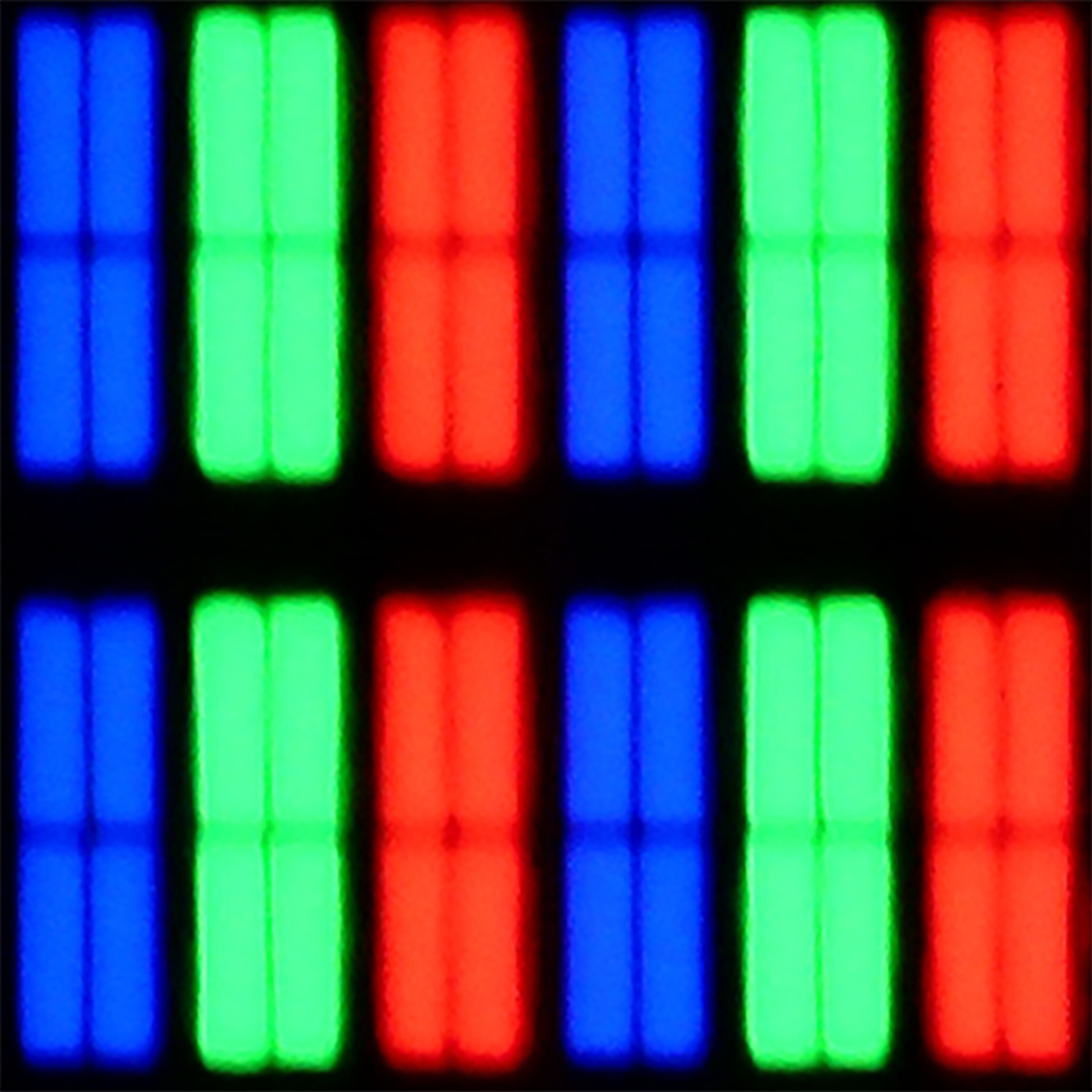
Panel uniformity and thermal imaging:

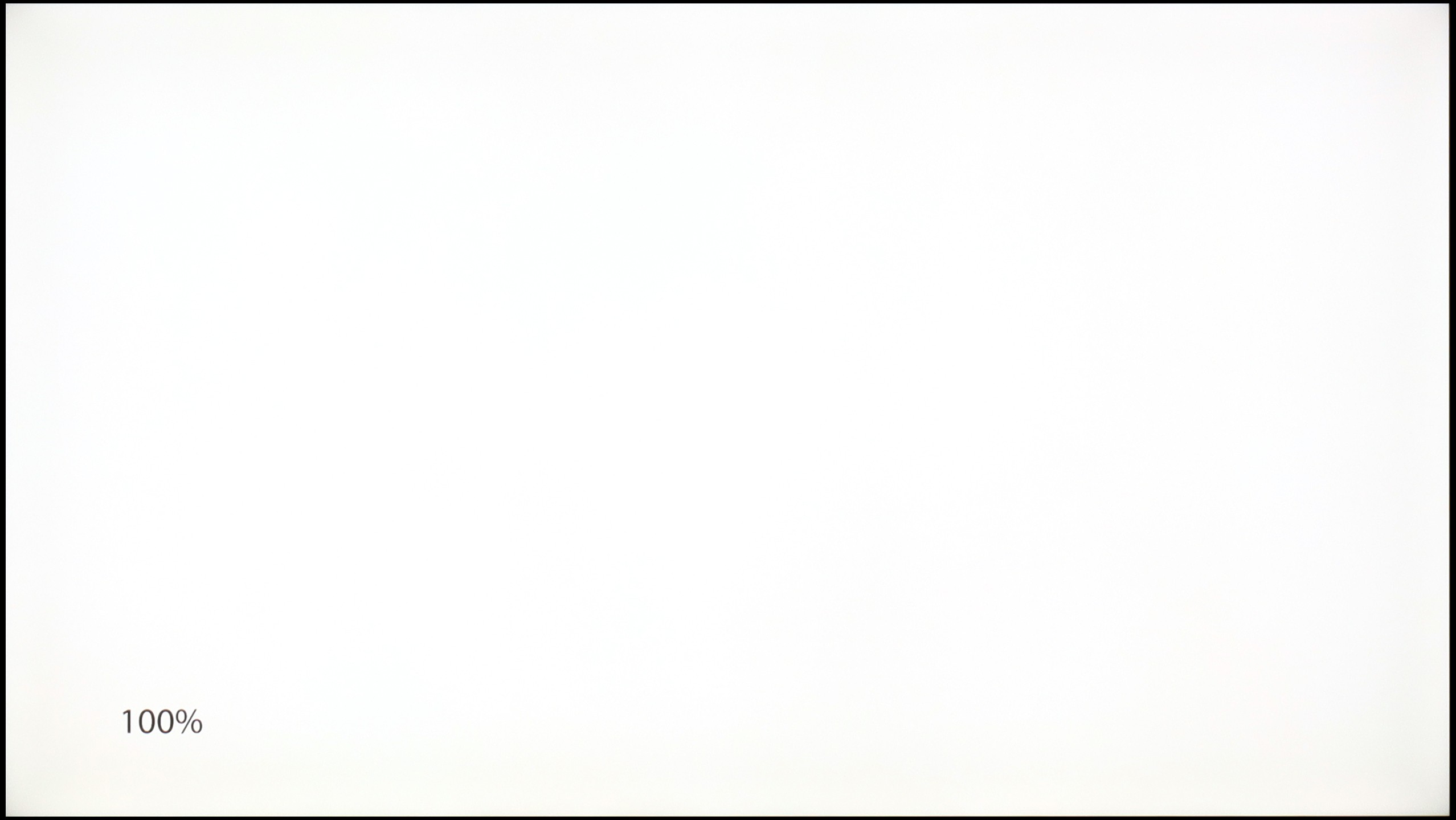
Samsung Neo QLED QN85D / QNX1D
Philips MLED920 / MLED910
TV features
7.4/10
5.5/10
- HDMI inputs0 x HDMI 2.0, 4 x HDMI 2.1 48Gbps0 x HDMI 2.0, 4 x HDMI 2.1 48Gbps
- OutputsToslink (Optical audio), eARC (HDMI), ARC (HDMI)Toslink (Optical audio), eARC (HDMI), ARC (HDMI), Mini-Jack (Headphones)
- Network InterfacesWi-Fi 2.4GHz, Wi-Fi 5GHz, Ethernet (LAN) 100MbpsWi-Fi 2.4GHz, Wi-Fi 5GHz, Ethernet (LAN) 100Mbps
- TV receptionDVB-T, DVB-T2, DVB-S, DVB-S2, DVB-CDVB-T, DVB-T2, DVB-S, DVB-S2, DVB-C
Classic features:
- Recording to USB (terrestrial TV)
- Recording programming
- Picture in Picture (PiP)
- RF remote control (no need to aim at the screen)
- Backlit remote control
- Teletext
- Audio only mode
- Bluetooth headphones support
- Simultaneous Bluetooth headphones & TV audio
Smart features:
- AirPlay
- Screen mirroring (Windows Miracast)
- Voice search
- Voice search in native language
- Ability to connect a keyboard and mouse


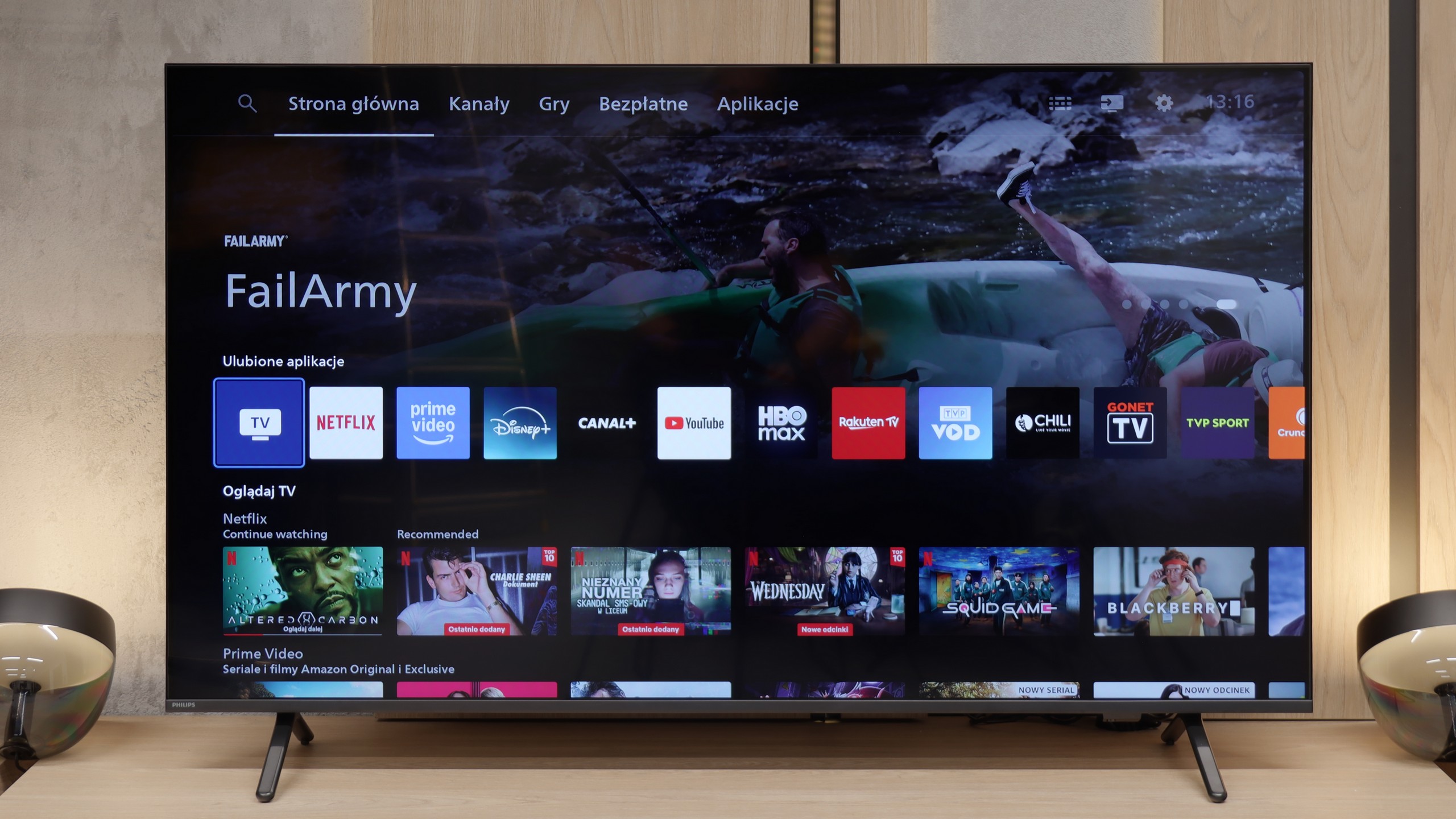
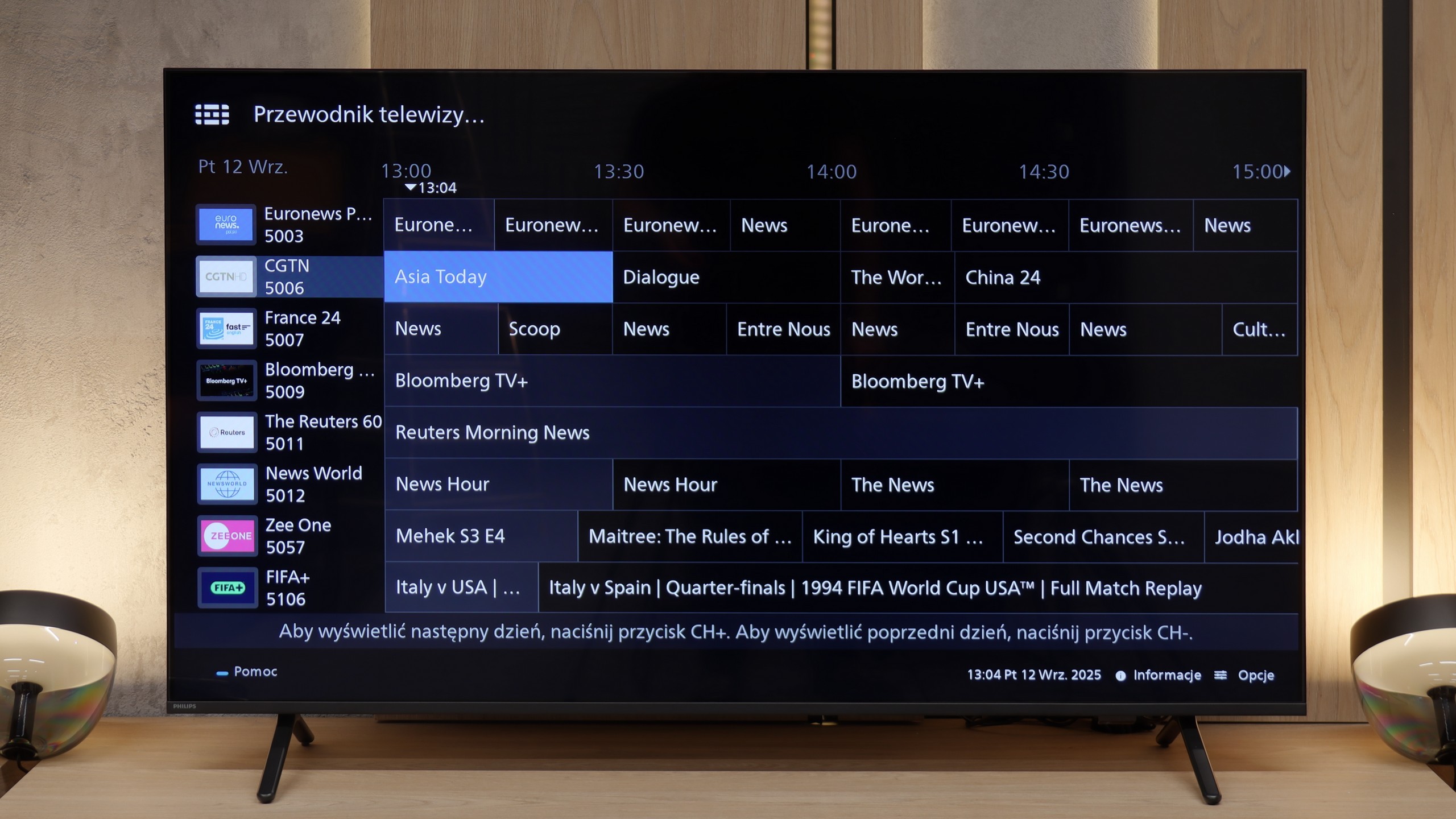
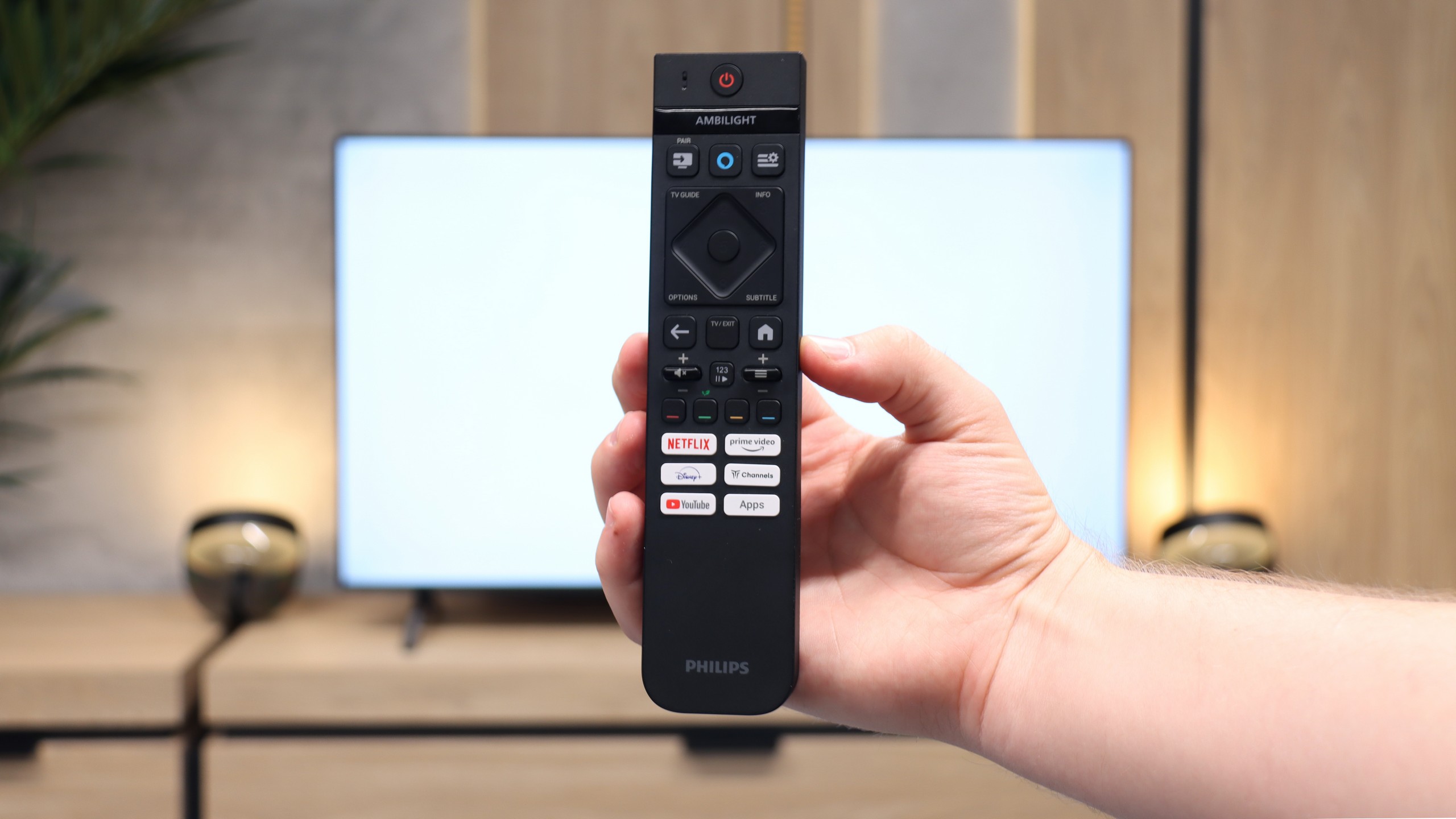
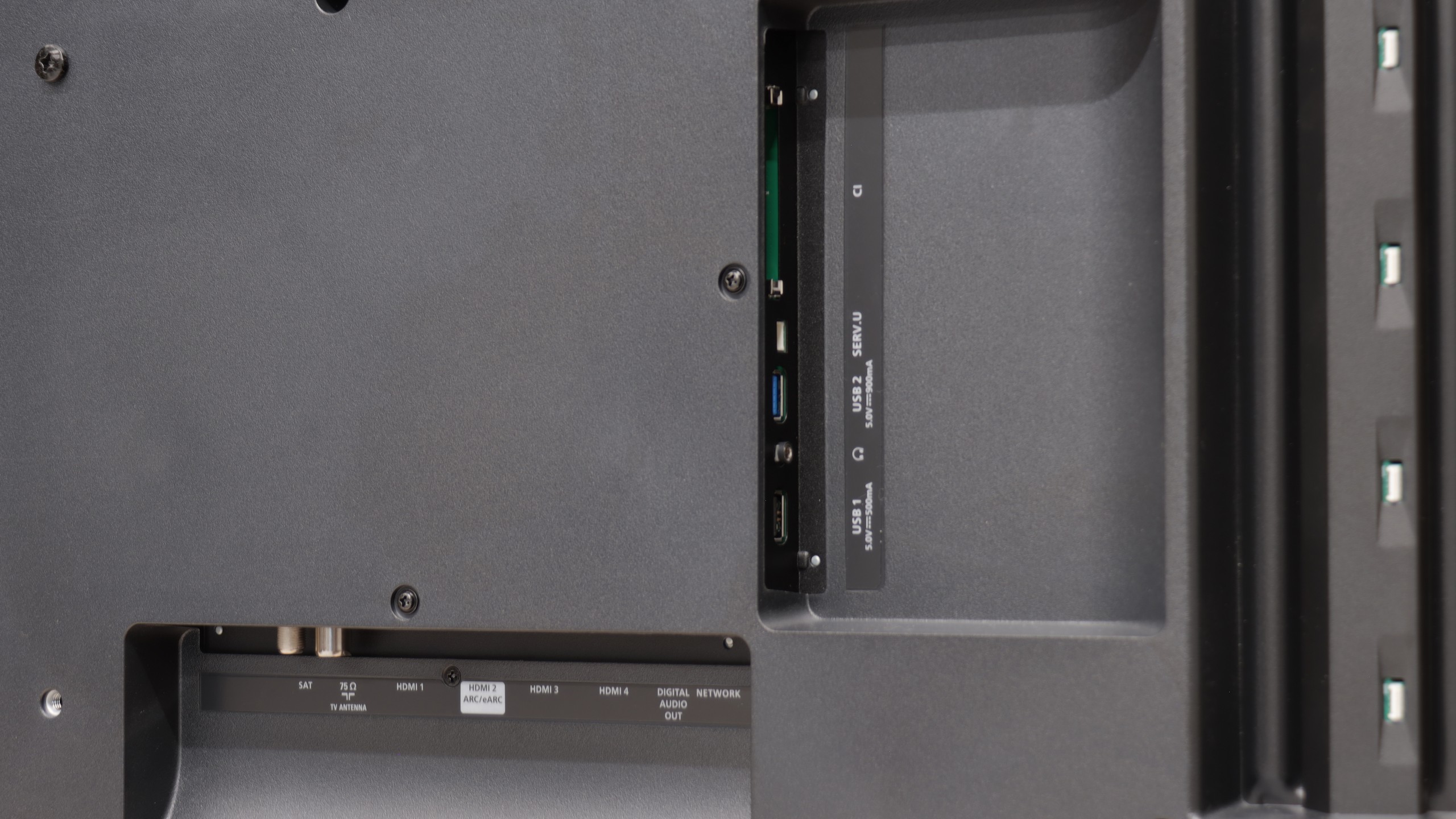
Samsung QN85D offers a wide range of smart features, thanks to the Tizen platform. Users have access to applications and features such as SmartThings, allowing management not only of Samsung devices but also equipment from other brands, creating a complete smart home ecosystem. The TV also supports AirPlay, enabling convenient content streaming from Apple devices directly to the screen, enhancing flexibility and comfort in everyday use.
Model QN85D also stands out in terms of unique features. The TV features Daily+, offering a variety of daily content such as fitness exercises or workspace. Additionally, the attractive appearance of the TV, while not as slim as last year's models, still presents well. The central stand provides solid support and adds character to the device, giving the TV a more elegant look.
In terms of user features, the TV is equipped with a remote that controls set-top boxes, such as Canal+, allowing easy control of most home equipment with a single device. The TV also has a PiP (Picture-in-Picture) function, enabling simultaneous viewing of two image sources. Unfortunately, one of the drawbacks that can be noticed is the lack of a recording function, which may be a significant downside for some users.
Smart TV – Titan OS
Philips MLED920 uses the proprietary Titan OS, which is just starting its adventure in the TV market and unfortunately, this is evident at every turn. On one hand, we have basic features – such as AirPlay support or the ability to mirror content from a smartphone, but on the other hand, its limitations quickly become apparent. Screen mirroring works only with a phone, but not with a laptop. Voice search? Yes, but it only works with Amazon Alexa and in languages supported by this assistant. The system operates fairly quickly, but every now and then it can "fail" and gives the impression of something that is underdeveloped and still evolving.
Classic TV Functions
Titan OS also doesn't excel in terms of classic TV functions. Aside from the hybrid remote with a numeric keypad – which is indeed backlit and thoughtfully designed in two modes, it unfortunately operates on infrared – there’s nothing here that would truly set the MLED920 apart from the competition. There’s a lack of USB recording or a PiP function, and such solutions could be useful in this class. From unusual additions, we have an analog output in the form of a jack, which allows for connecting headphones or older speakers. It’s a small nod to users who still use older equipment.
Ambilight TV
What definitely draws attention away from the shortcomings of Titan OS is the unique, three-sided Ambilight system. Here, Philips still plays in its own league and can impress those who haven't experienced this feature before. The colour backlighting that reacts to the content on the screen adds a unique atmosphere to viewing sessions and is something that the competition does not offer in a similar form. It is precisely Ambilight that is meant to ensure that other shortcomings – both system-related and functional – take a back seat.
Playing files from USB
9.1/10
8.5/10
Supported photo formats:
Maximum photo resolution:

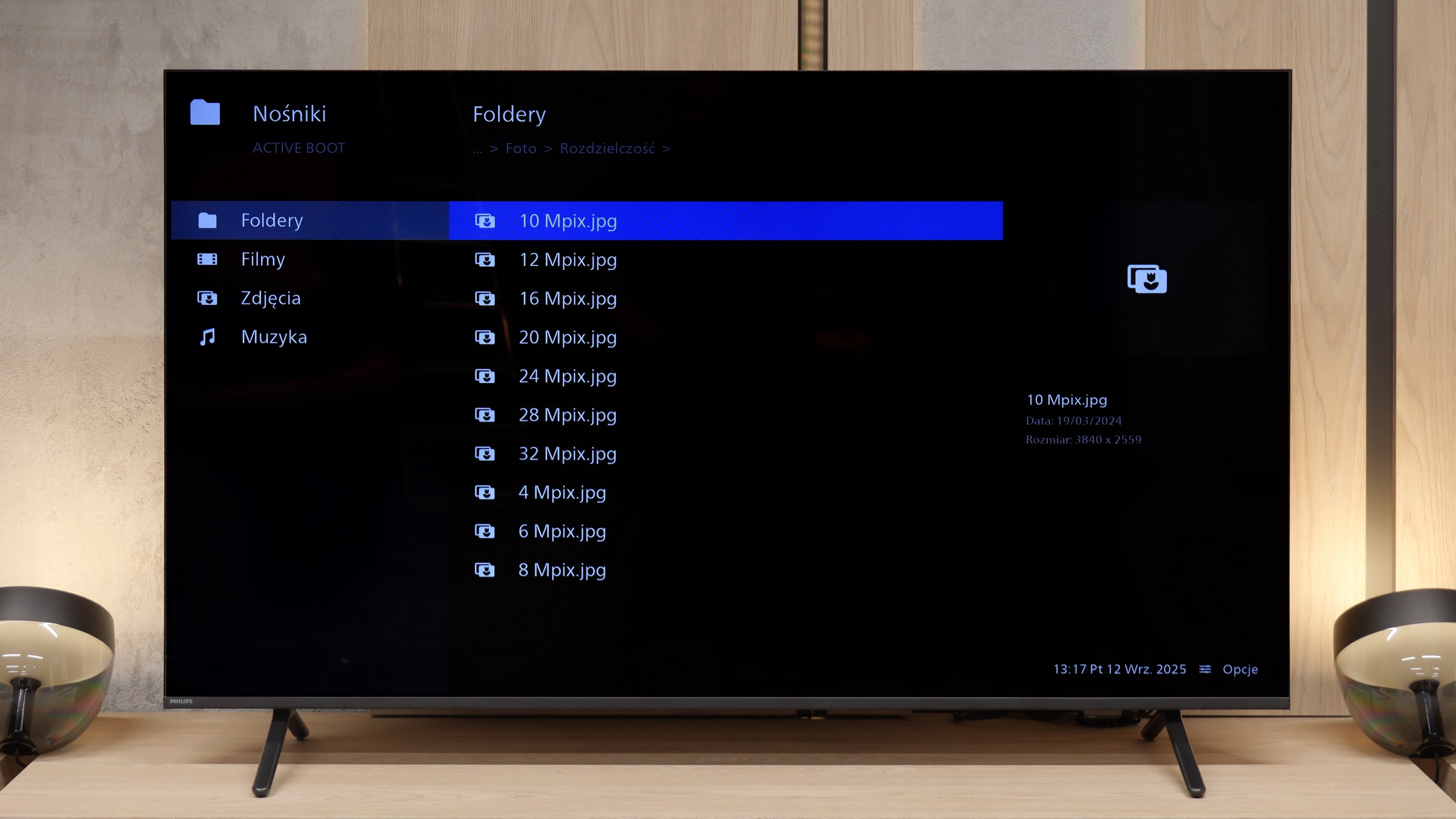
The built-in player in the Samsung QN85D should satisfy most users. It handles popular video and audio formats without much trouble, offering solid support for the most commonly used codecs. However, more demanding users may notice some shortcomings – it is not possible to play photos in the HEIC format, popular in Apple devices, as well as a few other, less common photo formats.
The built-in player in the Philips MLED920 works quite well and handles most popular audio and video files without any major issues – just as you can see in our test table. So there’s no worry about typical movie or music formats. The only complaint we can have is regarding its rather selective support for photo formats and some resolutions.
Apps
8.7/10
6.7/10














































Sound
7/10
6.2/10
- Maximum volume-88dB
- Dolby Digital Plus 7.1
- Dolby True HD 7.1
- Dolby Atmos in Dolby Digital Plus (JOC)
- Dolby Atmos in Dolby True HD
- DTS:X in DTS-HD MA
- DTS-HD Master Audio
The sound on the Samsung QN85D television is pleasant, with a subtle sense of bass and clarity across the entire volume range. This is thanks to the built-in 2.2 40W speakers. Unfortunately, the lack of support for the DTS audio format may be problematic for users wanting to enjoy a full sound experience. In such cases, it will be necessary to use an external player to get support for this format.
The sound in the Philips MLED920 is probably not the element that will impress you the most. It sounds fairly flat, lacking depth and clearer bass, which means movies or concerts don't have that extra layer of immersion that a better audio system can provide. However, it must be said that the volume is at a really decent level – the TV can ramp up to even 88 decibels. A big plus of the MLED920 is not so much the sound quality itself, but the support for audio formats. Philips has ensured compatibility with virtually all the major standards, including Dolby Atmos, DTS, and Dolby TrueHD 7.1. This means that if someone decides to connect an external soundbar or amplifier, they won't encounter any limitations and will be able to enjoy the full cinema sound.
Sound Quality Test
No sound test video
Acoustic Measurements
No acoustic data
88dBC (Max)
75dBC
